Amped Wireless ALLY00X19 Whole Home Smart Wi-Fi Range Extender User Manual Amped Wireless
Amped Wireless Whole Home Smart Wi-Fi Range Extender Amped Wireless
Contents
- 1. User Manuel
- 2. User Manual
User Manual

User’s Guide
Whole Home Smart Wi-Fi® System
ALLY-00X19, ALLY-00X19K, ALLY-00X21K, ALLY-R1900, ALLY-R1900K, ALLY-R2100K
TM
Plus

1
CONTENTS
INTRODUCTION .................................................. 3
GETTING STARTED .............................................. 4
Package Contents .................................................. 4
Status Lights ........................................................... 5
Buttons and Ports .................................................. 6
BASIC SETUP GUIDE ............................................ 7
Download the App ................................................. 7
Create Your Account .............................................. 7
Setup Your ALLY ..................................................... 8
Connect to ALLY ................................................... 10
Personalize your Wi-Fi Settings ........................... 12
SETUP THE ALLY EXTENDER ............................... 13
WEB MENU SETUP (ALTERNATIVE TO APP SETUP) ....... 15
USING THE ALLY APP ......................................... 21
Home Screen ....................................................... 21
Wi-Fi Networks .................................................... 22
Guest Wi-Fi .......................................................... 24
Devices ................................................................. 26
AVG protection .................................................... 27
Block devices ........................................................ 28
Activity Alerts (Push Notifications) ...................... 29
User Profiles ......................................................... 30
Pause the Internet ............................................... 33
Activity Report ..................................................... 33
Website Filters ..................................................... 35
App Blocking ........................................................ 37
Curfew .................................................................. 38
Advanced settings ................................................ 39
Privacy settings .................................................... 40
WEB MENU ........................................................ 41
Welcome to the Dashboard ................................. 42
Wi-Fi Settings: Basic Settings (5.0GHz) ................ 43
Wi-Fi Settings: Guest Networks (5.0GHz) ............ 45
Wi-Fi Settings: Advanced Settings (5.0GHz) ......... 46
Wi-Fi Settings: Wireless Coverage (5.0GHz)......... 47
Wi-Fi Settings: Access Schedule (5.0GHz) ............ 47
Wi-Fi Settings: Wi-Fi Protected Setup (5.0GHz) ... 49

2
Wi-Fi Settings: Basic Settings (2.4GHz) ................ 50
Wi-Fi Settings: Guest Networks (2.4GHz) ............ 52
Wi-Fi Settings: Advanced Settings (2.4GHz) ........ 53
Wi-Fi Settings: Wireless Coverage (2.4GHz) ........ 54
Wi-Fi Settings: Access Schedule (2.4GHz) ............ 54
Wi-Fi Settings: Wi-Fi Protected Setup (2.4GHz) ... 56
Network Settings: Local Network (LAN) .............. 57
Network Settings: Internet Network (WAN)........ 59
Network Settings: Advanced Settings .................. 61
Security Features: Block Websites ....................... 63
Security Features: User Access (MAC Filtering) ... 64
Security Features: User Access (IP Filtering) ........ 65
USB Storage: Local Sharing .................................. 66
USB Storage: FTP Server ...................................... 70
Firewall Settings: Port Filtering ............................ 71
Firewall Settings: Port Forwarding ...................... 72
Firewall Settings: DMZ (Demilitarized Zone)........ 73
Firewall Settings: Denial of Service ...................... 74
Quality of Service ................................................. 75
Management: System Status ............................... 76
Management: Network Statistics ........................ 77
Management: Dynamic DNS Settings .................. 78
Management: System Clock ................................ 79
Management: System Logs .................................. 80
Management: Upgrade Firmware........................ 81
Management: Save and Reload Settings ............. 83
Management: Access Code .................................. 84
TECHNICAL SPECIFICATION ................................ 84
DEFAULT SETTINGS ............................................ 86
TROUBLESHOOTING & SUPPORT INFO ............... 87
WARRANTY AND REGULATORY INFO ............... 114
LEGAL NOTICES & DISCLAIMERS ...................... 122

3
INTRODUCTION
Thank you for purchasing The ALLY Plus- Whole Home Smart Wi-Fi System. At Amped Wireless we strive to
provide you with the highest quality products through innovation and advanced technology. We pride
ourselves on delivering products that outperform the competition and go beyond your expectations. If you
have any questions, please feel free to contact us. We’d love to hear from you and thank you for your
support!
Email: sales@ampedwireless.com
Call: 888-573-8830
Web: www.ampedwireless.com

4
GETTING STARTED
Package Contents
Check to make sure you have all the contents within your package:
ALLY Router
ALLY Extender
RJ-45 Ethernet Cable
2 x Power Adapters
Setup Guide
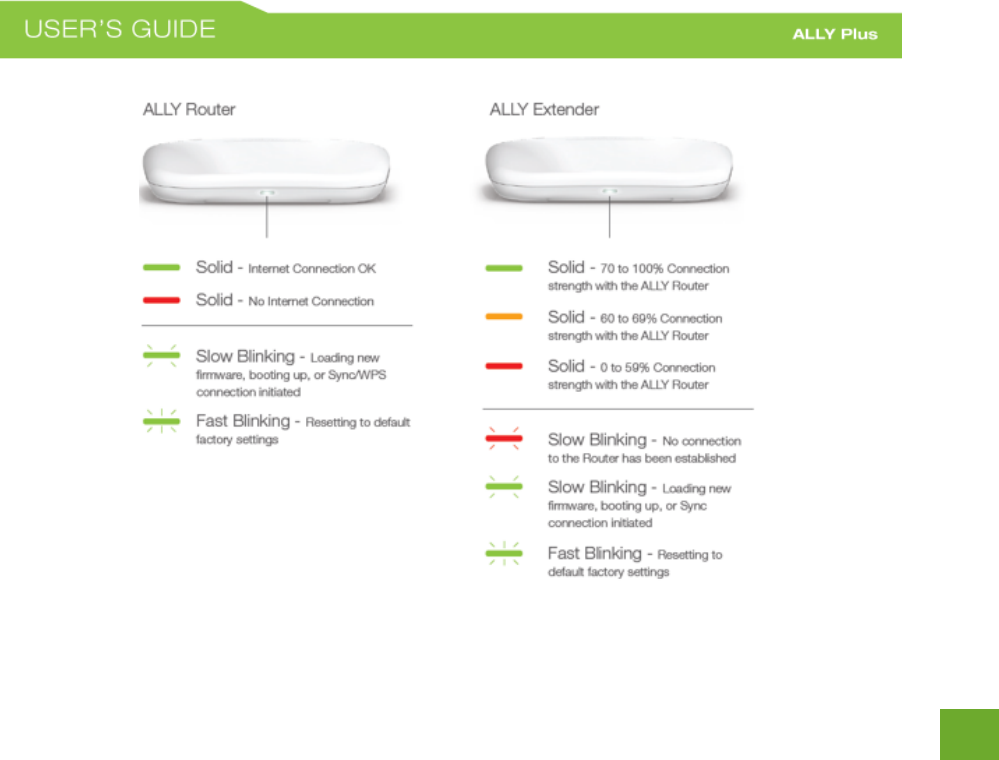
5
Status Lights
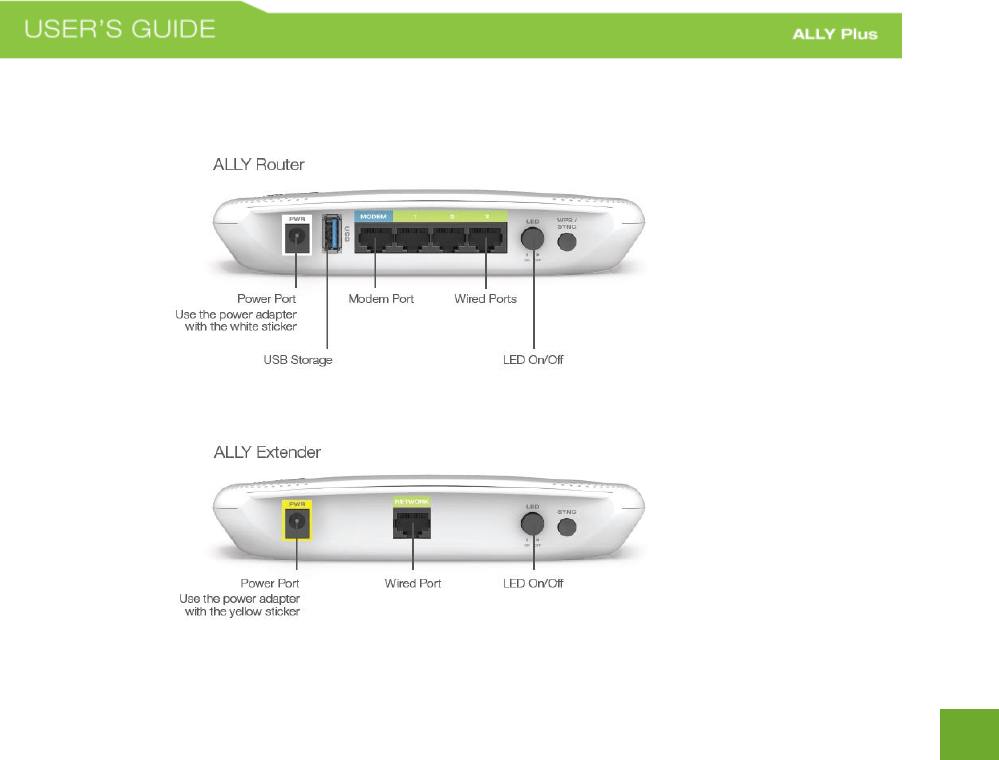
6
Buttons and Ports
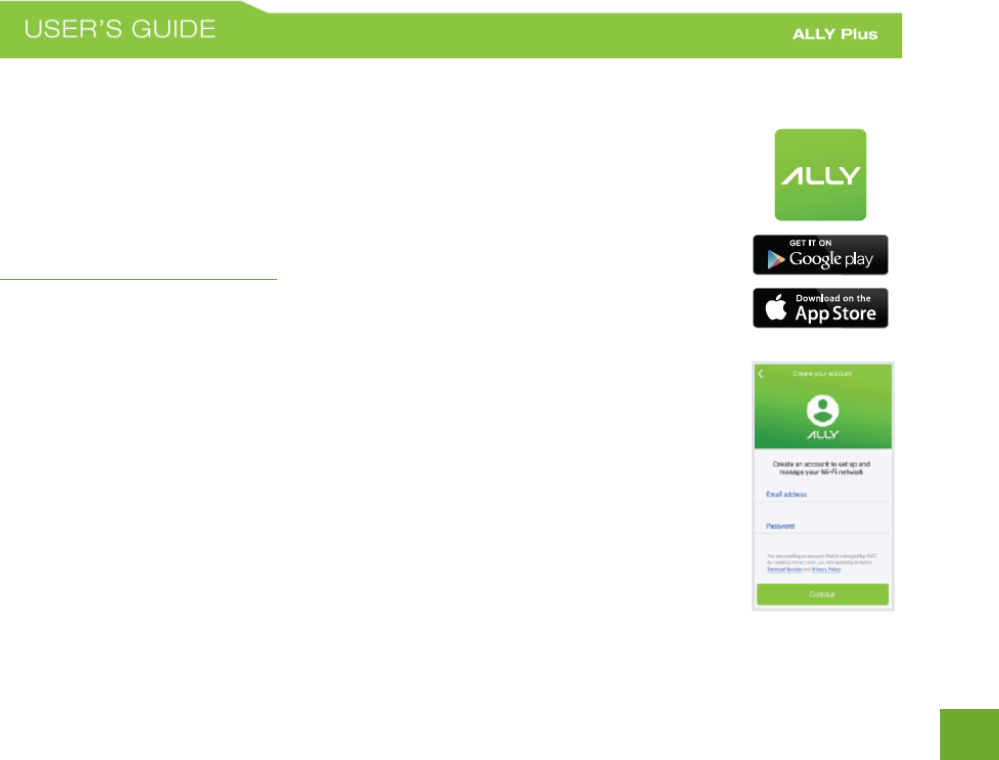
7
BASIC SETUP GUIDE
Download the App
Download the Amped Wireless ALLY app on your Android or iOS device. Search for
ALLY Whole Home Wi-Fi System on the Google Play or Apple Store, or visit
www.ampedwireless.com/allyapp We support Android 4.4+ and iOS 9+.
Create Your Account
Open the App and create your account. The account allows you to securely manage your
ALLY from anywhere and from any device.
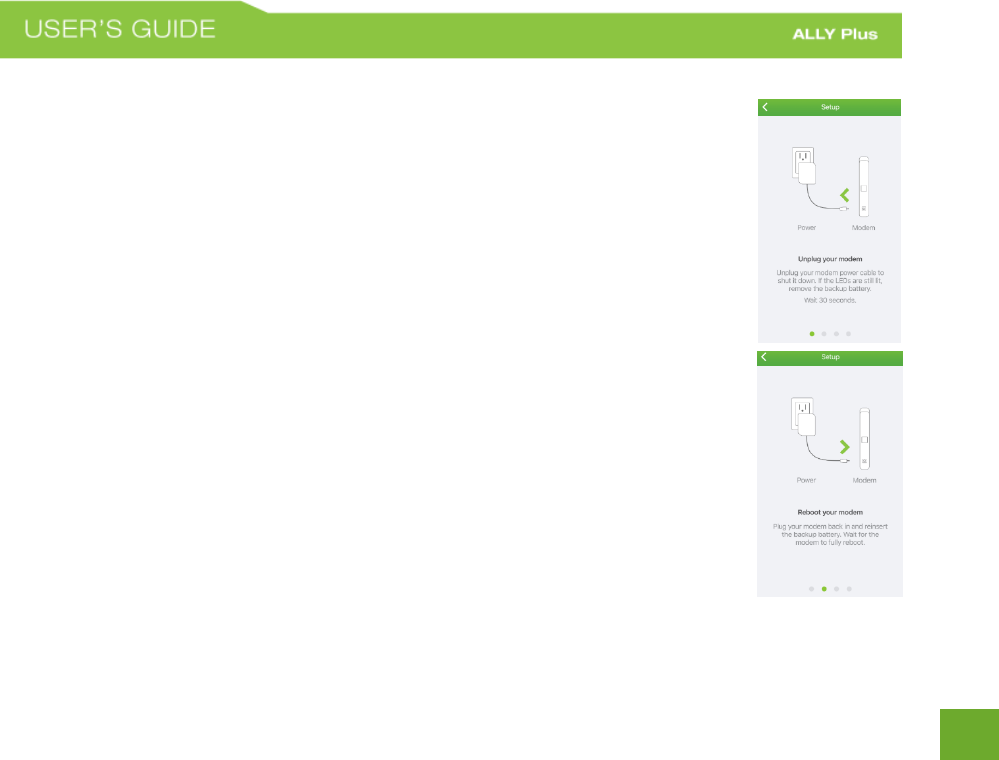
8
Setup Your ALLY
Follow the steps in the app to get your ALLY up and running.
Unplug your Modem
Power off the modem by disconnecting the modem’s power adapter from the power
outlet. If your modem has a backup battery, remove the backup battery from your
modem.
Reboot your Modem
Plug in your modem’s power adapter and backup battery (if available):
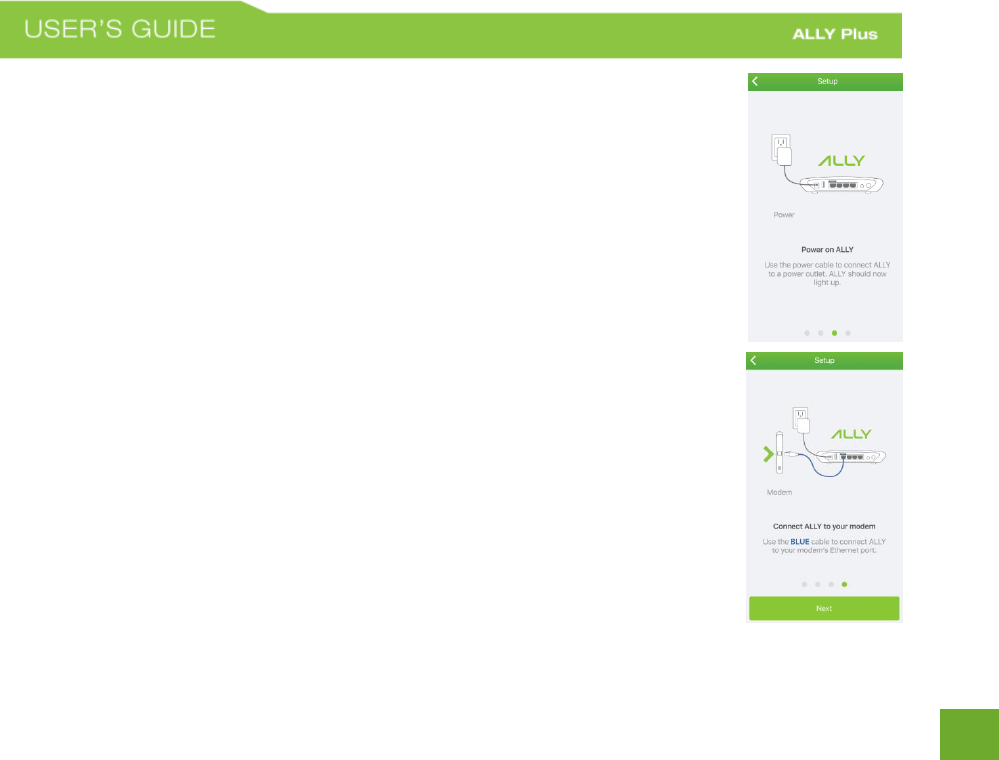
9
Power on ALLY
Locate your ALLY Router and the power adapter that goes with the ALLY Router (the
power adapter with the white sticker) Attach one end of the power adapter to an
available power outlet and the other to the white PWR port on the back of the ALLY
Router
Connect ALLY to your Modem
Connect the ALLY Router to your modem using the included blue Ethernet cable. One
end of the cable should be already attached to the blue Modem port on the ALLY Router.
The other end should be connected to your modem.

10
Connect to ALLY
After you have connected the ALLY to your modem you will be asked to connect to the
ALLY’s Wi-Fi network as shown on the screens to the right. The upper screen is what iOS
users will see while the lower screen is what Android users will see.
Leave the ALLY App and go to your phone’s Wi-Fi settings. Find the Wi-Fi network
named: Amped_ALLY_XXXX and connect to it.
Once you have connected return to the ALLY App
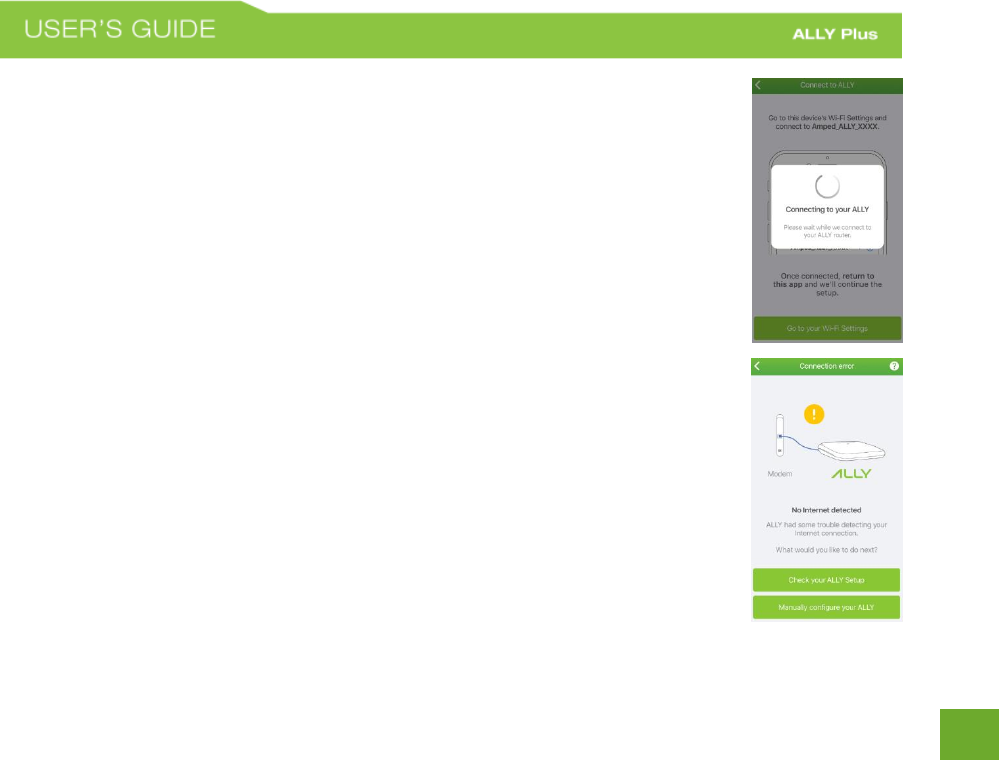
11
Internet Connection Detection
The ALLY App will try to detect your Internet settings and configure the ALLY router.
Please be patient. Once your connection has been successfully configured you will be
directed to configure your Wi-Fi network settings.
If there is a problem with the configuration, the app will notify you of the issue as shown
in the screen on the lower right. At this point, please tap Check your ALLY Setup to
ensure you have connected your hardware correctly or if you choose to manually enter
your configuration settings tap the selection to do so (Do this for static IP, PPPoE or other
non DHCP, based installations). If you continue to have problems, contact our Elite
Support department at 888-573-8820.
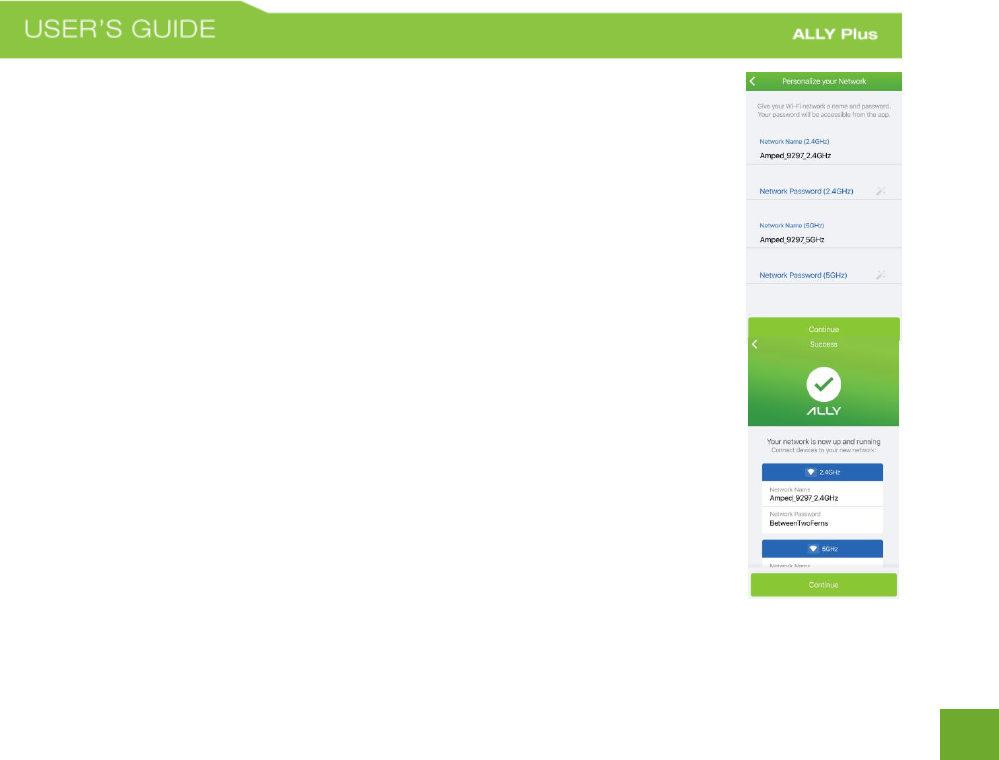
12
Personalize your Wi-Fi Settings
If your Internet connection was configured successfully you will see the “Personalize your
Network” screen where you can give your Wi-Fi network a new name and password. You
may also choose to have the ALLY app generate a password for you.
Note: You may choose to use the same network name and password for both 2.4GHz and
5GHz networks or choose individual ones for each. 2.4GHz networks will have longer
range while 5GHz networks have faster speeds is the more optimal network for media
streaming and other data intensive devices.
Summary
Once you have successfully named your network and selected a password you will be
directed to the summary of your settings. Tap continue to begin customizing your ALLY
experience.

13
SETUP THE ALLY EXTENDER
Do not power on your ALLY Extender until after your ALLY Router has been configured. Once your ALLY Router
has been configured follow the steps to configure the ALLY Extender.
a) Find a spot halfway between your ALLY Router and the far end of your home. If you have a two story
home, it is recommended that your ALLY Router and ALLY Extender are on opposite floors.
b) Power on the ALLY Extender using the included power adapter with the yellow sticker. Attach one
end of the power adapter to an available power outlet and the other end to the yellow PWR port on
the ALLY Extender.
c) Wait about 2 to 3 minutes, or until the LED stops blinking and turns a solid green, orange or red. If
the light is green or orange, then you’ve found a good spot. IF the light turns solid or blinking red,
then the ALLY Extender is too far from the ALLY Router. Move it closer and try again until the light
turns solid green or orange.
See the diagram on the following page for detailed instructions.

14

15
WEB MENU SETUP (ALTERNATIVE TO APP SETUP)
The ALLY is meant to be installed using the ALLY app. If you reached this section and have not begun setup
yet, please refer to the Basic Setup Guide on page 7. In the case that you do not have an Android 4.4+ or iOS
9+ device and still wish to use the ALLY without the ALLY app, follow the instructions below.
Note: We strongly recommend that you use the ALLY App to enjoy the overall experience of the ALLY system.
If you have already configured your ALLY using the app you will need to access your ALLY app to obtain the
access code to access the web menu.
a) Power on the ALLY Router and attach the included Ethernet cable to your modem and the other end
to the modem port of the router.
b) Connect your PC or tablet to the ALLY Wi-Fi network: Amped_ALLY_XXXX
c) Open your web browser.
d) Type http://setup.ampedwireless.com
into the web address bar.
e) If the web menu fails to open, type the following IP
address into your web address bar:
http://192.168.3.1
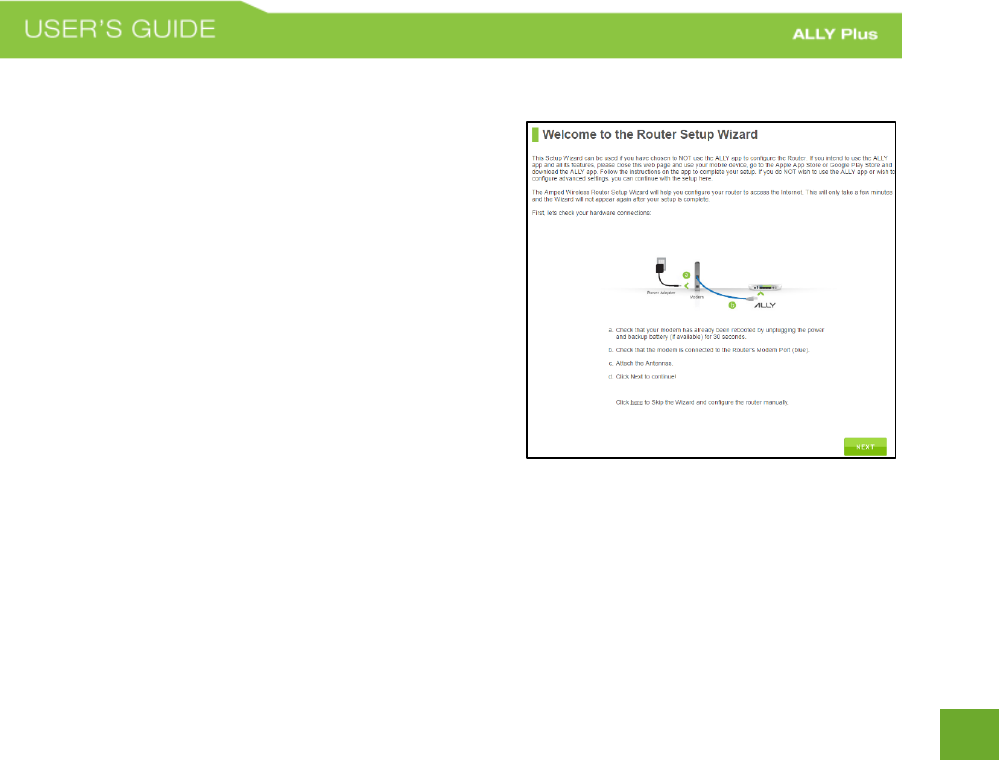
16
Welcome to the Setup Wizard
If this is your first time setting up the Router, the Setup
Wizard should automatically load.
If you wish to manually configure your router you can also
choose to skip the Setup Wizard.
Double check that the modem is connected to the Router’s
Modem port.
Check that your antennas are all attached firmly to the
antenna connectors.
Click Next to continue.

17
If the Dashboard loads (see right image) instead of the Setup
Wizard, scroll to the bottom and click the Setup Wizard
button to access the Wizard.
Internet Connection Detection
The Wizard will try to detect your Internet settings and
configure the router. Please be patient.
If there is a problem with the Automatic Configuration, the
wizard will notify you of the issue. If you continue to have
problems, contact our Elite Support department at 888-
573-8820.
If the Internet connection detection was successful, you
will see a green check mark.
Click Next to continue.

18
Personalize your Wi-Fi Settings
The default ID of your 5GHz and 2.4GHz Wi-Fi
network is:
Amped_ALLY_XXXX
To change it, enter a new name in the SSID field.
Users connecting wirelessly to the Router will
use these IDs to identify your wireless network.
There is no default security key.
To change them, enter a new key in the Security Key field for both 2.4GHz and 5GHz networks. The keys must
be at least 8 characters long.
Click Next to apply your settings.
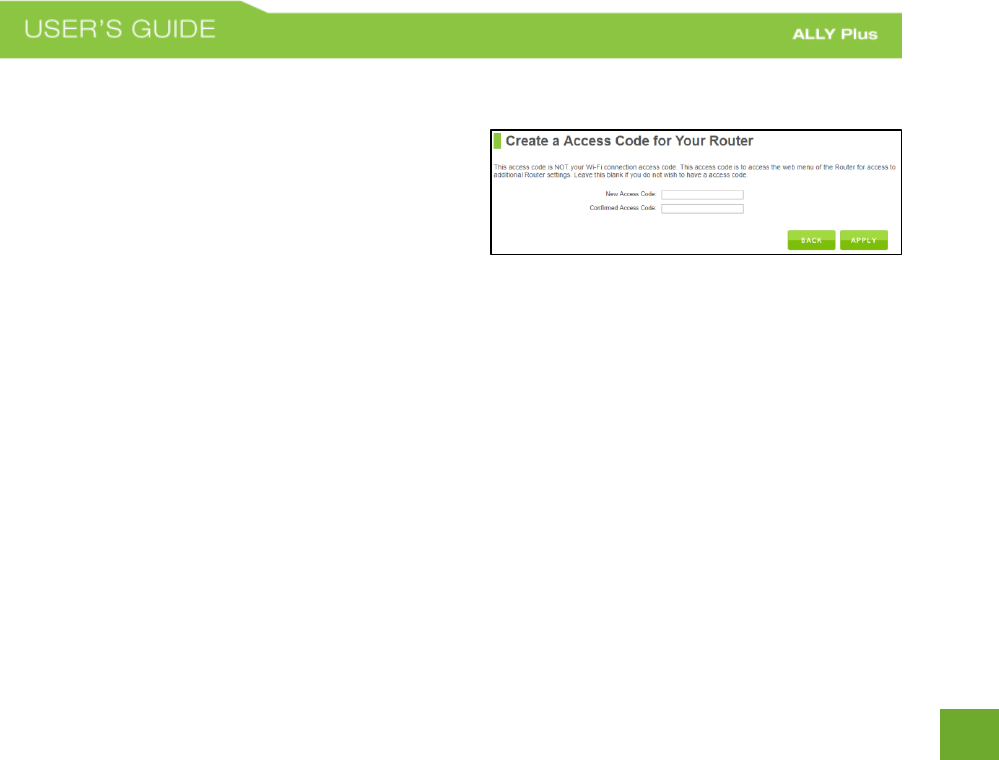
19
Create a Password for your Router
This password is NOT your Wi-Fi network password. This
password is to access the web menu of the Router to
access additional router settings. Leave this blank if you
do not wish to have a password.
Click Apply to save your settings.
The Router will reboot. This process may take up to 1 minute. The page will automatically reload after the
countdown. If it does not, you may need to manually refresh the page or check your connection to the Router.
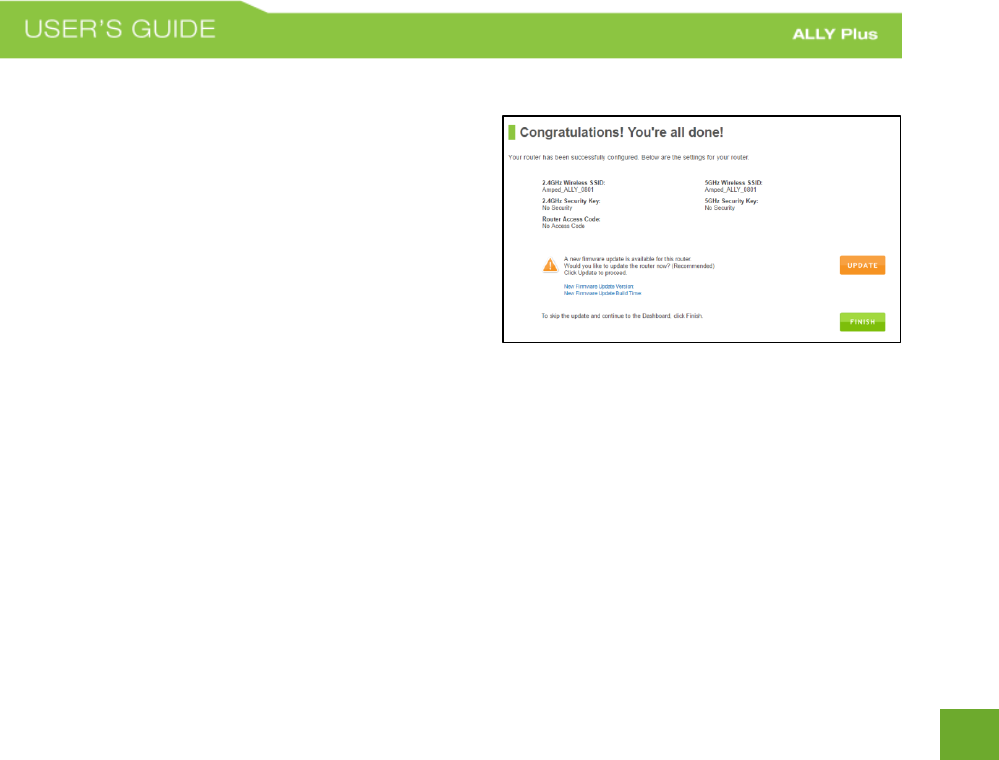
20
Setup Summary
Once the Router has rebooted, it will load the Setup
Summary page and provide you with the details of your
setup. It is recommended that you print this page for your
records.
Open a new web browser window and check that you have
access to the Internet.
At this time, you may disconnect from the Router and start
a wireless connection.
If you have any wired devices that you would like to attach to the Router you may do so now as well.
Enjoy your new Amped Wireless network!
If there is a new firmware update available, you will be prompted to update the firmware. To do so click
“Update”
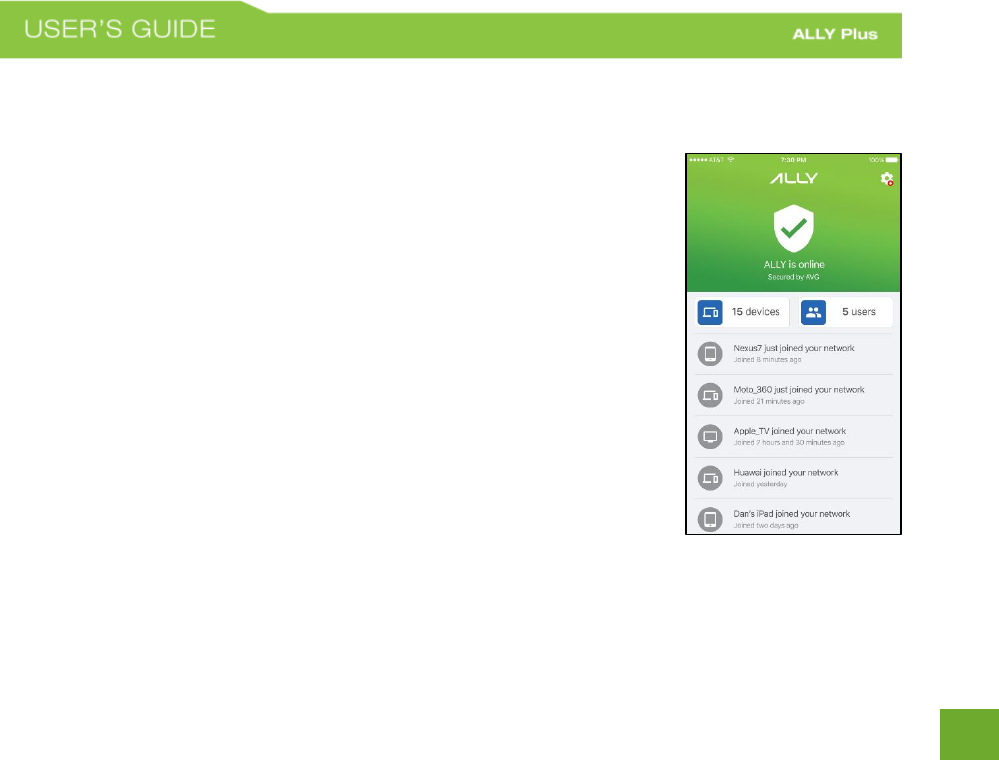
21
USING THE ALLY APP
Home Screen
Home screen lets you see the status of your network and access all of ALLY’s
features.
a) Network status (top section):
If online, it says “ALLY is online” and section color is green
If offline, it says “ALLY is offline” and section color is red
b) Settings: Check for updates, change Wi-Fi passwords and more.
c) Users: View and create user profiles. The number in the button
represents the number of users you have created on your network.
d) Devices: Manage and view the devices on your network. The
number in the button represents the number of devices that have
connected to your network.
e) Activity: Get a glance of recent network activities (e.g., when a new
device joins your network)
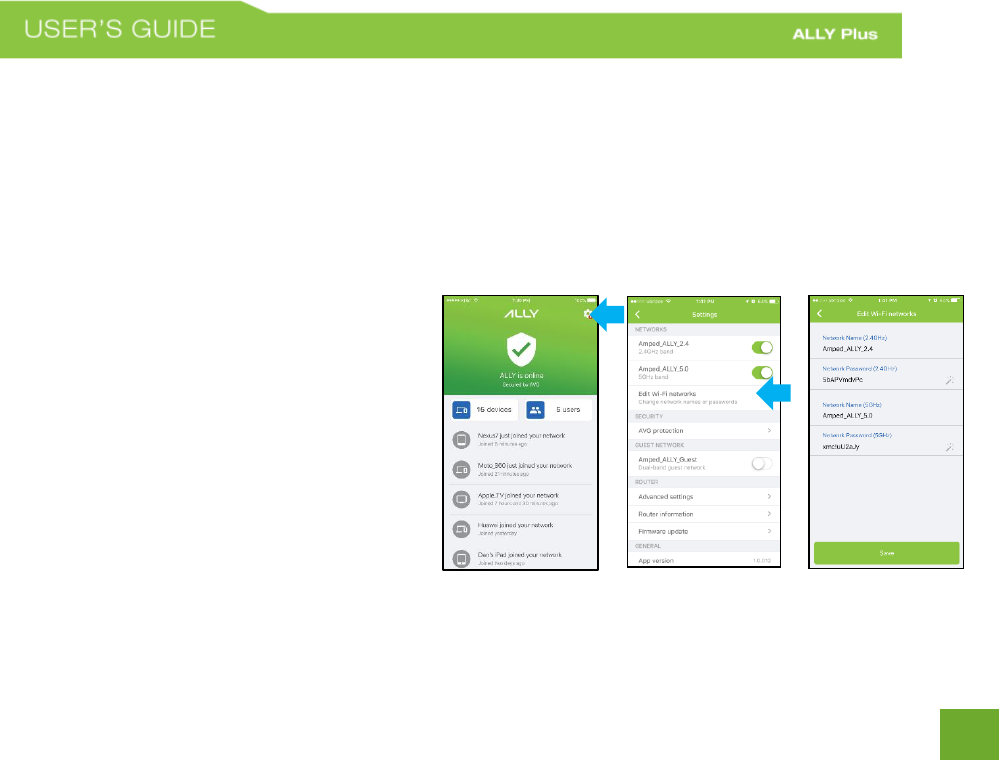
22
Wi-Fi Networks
Find your Wi-Fi passwords
a) Open the ALLY app
b) On the Home screen, tap the Devices button to open the Connected Devices list. Tap the + sign
in the top-right corner. Here you can see the network names and passwords for all your Wi-Fi
networks.
NOTE: You should be careful about who
you give your passwords to.
Change the Wi-Fi network name and password
a) Open the ALLY app
b) On the Home screen, tap the gear icon
in the upper-right corner to open the
Settings menu.
c) Under the Network section, tap Edit Wi-
Fi Networks.
d) To edit, tap the network name or the network password. Enter a new network name and/or

23
network password.
NOTE: Passwords must be 8 to max 15 characters long.
TIP: Tap the magic wand to create a strong password automatically.
e) When done, tap Save.
Using the 2.4GHz and 5GHz bands
a) ALLY has two separate Wi-Fi networks – one for the 2.4GHz band and another for the 5GHz band.
So you can connect your devices to the band you want.
b) The 5GHz network is faster than the 2.4GHz network but the 2.4GHz will have more range.
c) Older devices may only support the 2.4GHz band.
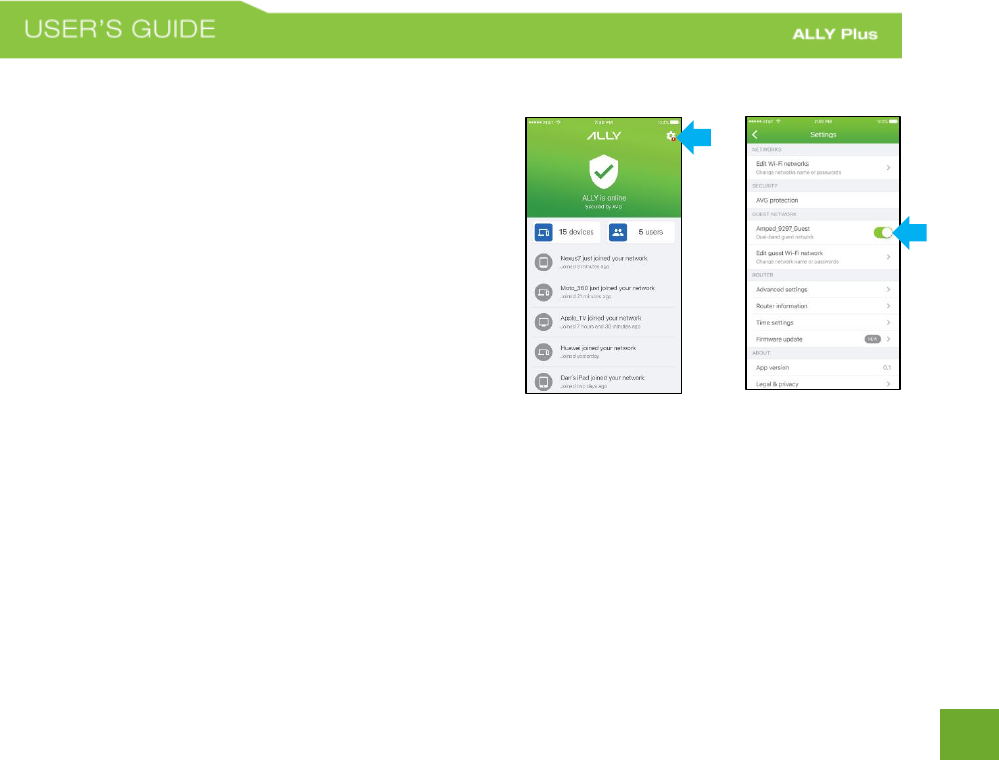
24
Guest Wi-Fi
Guest Wi-Fi allows you to share your Wi-Fi with visitors
without giving them access to your main network where all
your personal devices are communicating
To turn on the Guest Wi-Fi
a) Open the ALLY app
b) On the Home screen, tap the gear icon in the
upper-right corner to open the Settings menu.
c) Under the Guest Network section, toggle the
Guest Wi-Fi switch to turn on.
You can disable the Guest Wi-Fi at any time by following
the same steps.
a) Edit Guest Wi-Fi
a) On the Home screen, tap the gear icon in the upper-right corner to open the Settings menu.
b) Under the Guest Network section, tap Edit Guest Wi-Fi Network.
c) To edit, tap the network name or the network password. Enter a new network name and/or
network password. Passwords must be 8 to max 15 characters long.
TIP: Tap the magic wand to create a strong password automatically.

25
d) When done, tap Save.
Find the Guest Wi-Fi password
a) Open the ALLY app
b) On the Home screen, tap the Devices button to open the Connected Devices list.
c) On the Devices screen, tap the + sign in the top-right corner.
d) Tap Guest to see the name and password of your Guest Wi-Fi network.

26
Devices
Devices screen lets you see all registered devices in your
network, status of these devices i.e. whether they are online
or offline and their host/manufacturer names
Tap on a device in the list to view and edit Device Settings.
Device Settings allows you to Block the device from the
network, assign the device to a different user, and change
device details.
o Edit: Rename device
o Block button: Tap to block device.
o Owner: Assign the device to a different user

27
AVG protection
AVG protection helps you protect the devices on your network from malware and phishing attacks by blocking
harmful websites
To enable AVG protection:
a) On the Home screen, tap the gear icon in the upper-right corner to open the Settings menu.
b) Under the Security section, tap AVG protection.
c) Toggle the Online Shield switch to turn on.
You can turn off AVG protection at any time by following the same steps.

28
Block devices
ALLY gives you the power to block devices from accessing your network.
To Block a device
a) On the Home screen, tap Devices.
b) Select the device that you want to block from the list.
c) Tap Block on the Device Settings screen.
To Unblock, tap again.

29
Activity Alerts (Push Notifications)
ALLY notifies you of important events on your network so you are always in control of what is happening for
example when a new device joins your network
You can enable or disable Activity Alerts by adjusting your
phone’s push notification settings.
a) For iOS devices: Go to your device’s Settings
and then Notifications. Scroll down to find ALLY.
Click on Notifications. Toggle Allow
Notifications to On or Off.
b) For Android devices: Go to your device’s
Settings. Scroll down to Sounds and
Notifications. Tap App Notifications. Scroll
down to ALLY. Turn notifications on or off.
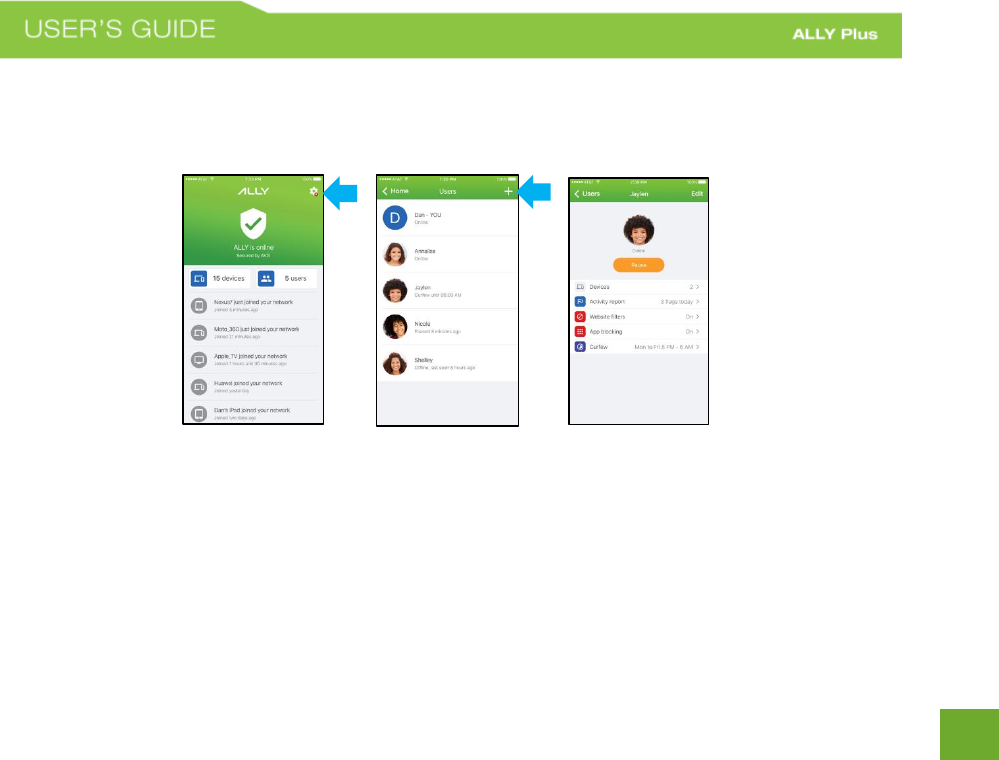
30
User Profiles
User Profiles allow you to customize your kids’ online experience, set Internet-free moments, and keep a tab
on what your kids’ are up to.
To create User Profiles for your family members
a) On the Home screen, tap Users.
b) Tap the + sign in the top-right corner to Create a New User.
c) Enter a name and add a photo (optional).
d) Select the devices that you’d like to assign to the profile.

31
NOTE: ALLY will apply the profile settings to the devices that you select. A device can be assigned to
only one user profile at a time.
e) Tap done in the upper-right corner.
To add and remove devices to and from a User Profile
a) On the Home screen, tap Users
b) Tap the profile you want to update
c) On the User Profile screen, tap Devices
d) Select the devices that you want to assign to the profile
You can also assign devices to individual profiles from the Device Settings screen
a) On the Home screen, tap Devices
b) Select the device that you want to add to a profile
c) On the Device Settings screen, tap Owner
d) Select the profile you want to assign the device to
NOTE: ALLY works by assigning a device to only one user profile at a time to avoid conflict between
different filters, schedules and pauses. If a device is shared between family members, you may want to
create a separate profile for that device.
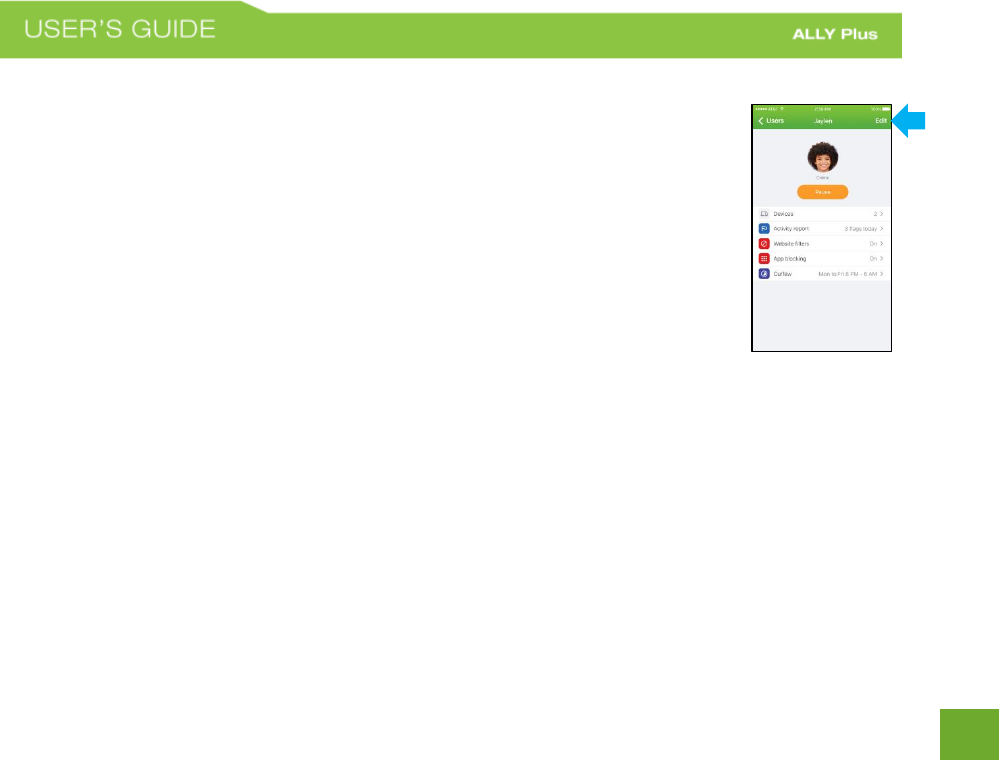
32
To edit or delete a User Profile
a) On the Home screen, tap Users.
b) Select the user profile that you want to edit or delete.
c) On the User Profile screen, tap Edit. Here you can change the profile name
and photo, and delete the profile.
NOTE: When you delete a User Profile the devices associated to that profile will be
become unassigned. You can add them to a different user profile or keep them
unassigned.

33
Pause the Internet
ALLY allows you to Pause the Internet for individual family members whenever you think that offline time is
needed. For scheduled offline time, see the Curfew section below.
To Pause a Family Member
a) On the Home screen, tap Users.
b) Tap the family member you want to Pause.
c) On the User Profile screen tap Pause.
d) To Resume, tap again.
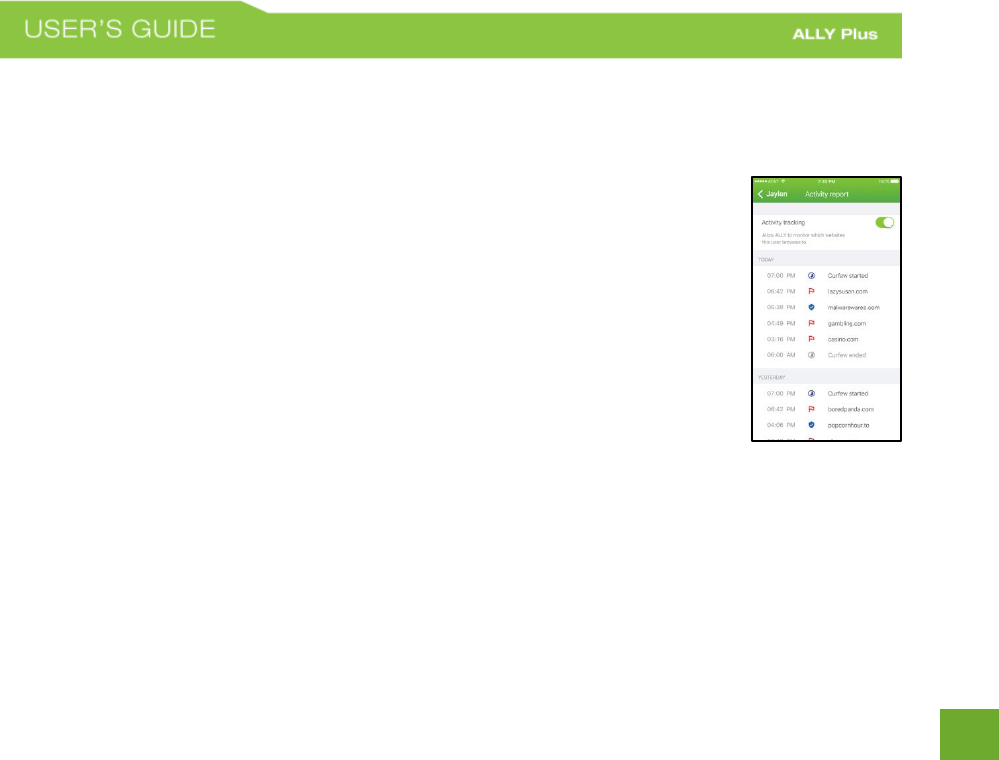
34
Activity Report
Activity Report lets you keep an eye on your family members’ online activity, so you can always intervene if
they stumble across harmful content.
To view your family members’ online activity, you must first enable Activity Tracking.
To turn Activity Tracking on
a) On the User Profile screen tap Activity Report.
b) Toggle the Activity Tracking switch to turn on.
NOTE: ALLY starts monitoring which websites they browse to only once activity tracking is
enabled. After enabling, it may take some time for activity to show up in the Activity
Report. ALLY will only show the online activity of devices that were assigned to that user.
To stop Activity Tracking
a) On the User profile screen, tap Activity Report.
b) Toggle the Activity Tracking switch to turn off.
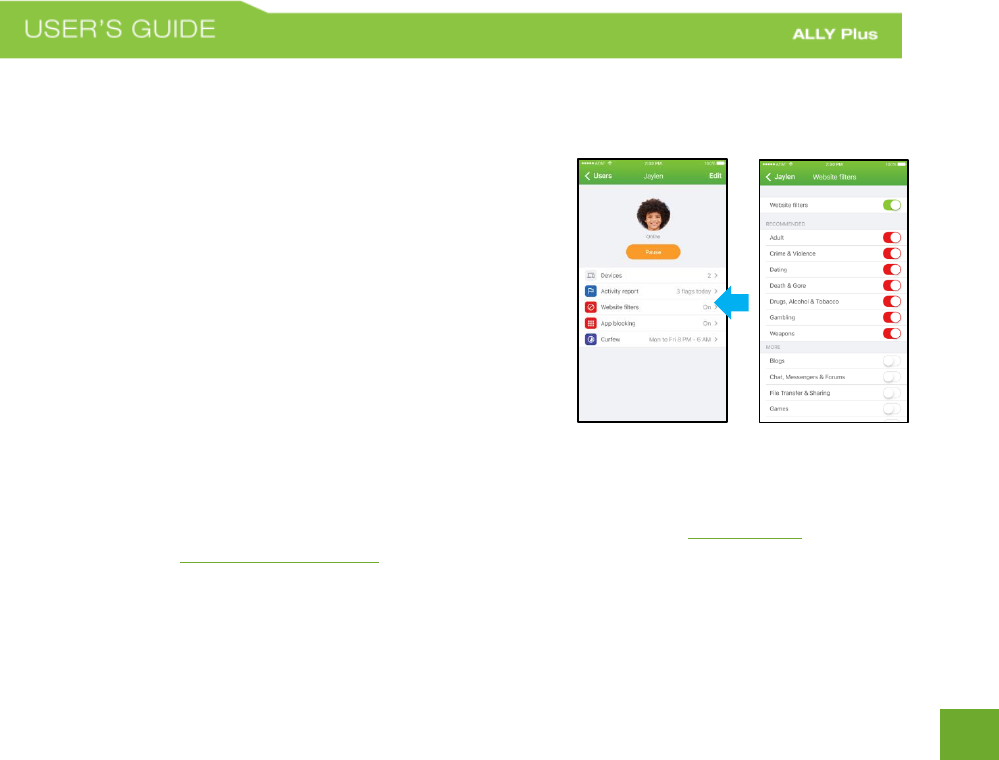
35
Website Filters
Website Filters let you set limits on what each family member can see and access online by filtering out
content and blocking specific websites.
To set Website Filters
a) On the User Profile screen, tap Website Filters.
b) Toggle the Website Filters switch to turn on.
c) Switch toggles on to filter out content. Switch toggles
off to allow content.
You can tap on a category to read a category
description.
d) Tap the Back button when finished.
To Block a specific website
a) On the User Profile screen, tap Block a Website.
b) Enter the domain of the site that you want to block.
You can only enter domain names and not URLs. For example, www.xyz.com instead of
http://xyz.com/category.
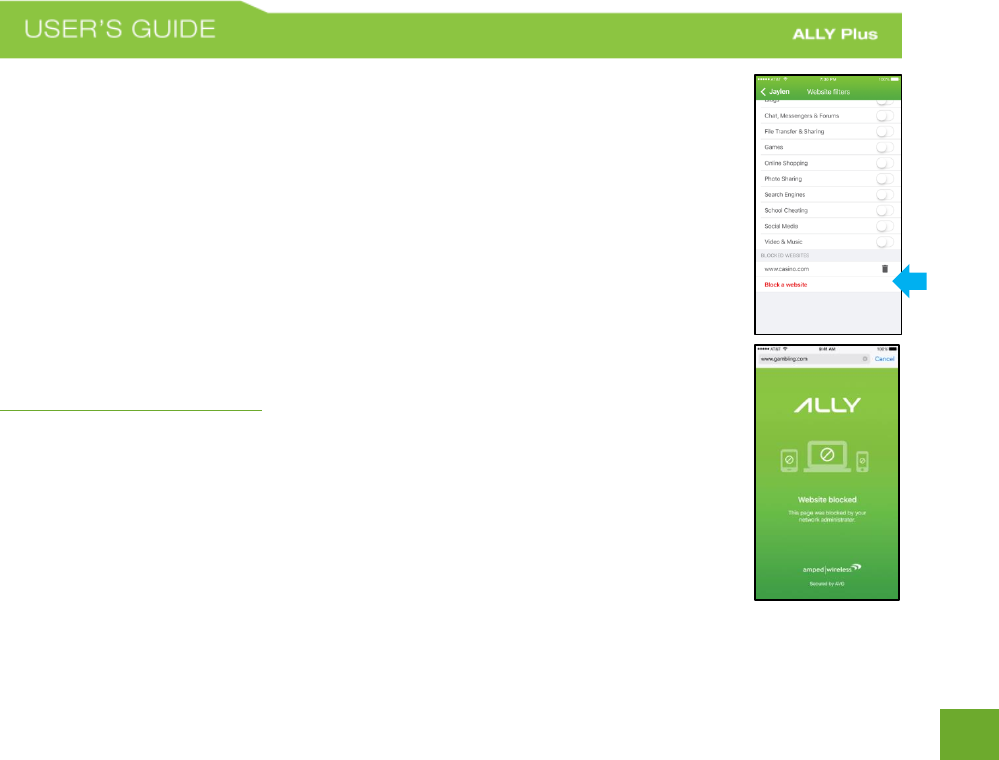
36
Please note this will block entire website behind that domain
c) Tap Add. The website will appear under the Blocked Websites section on the
Website Filters screen.
To Unblock the website, tap the Bin icon next to the website address.
Note: If ALLY blocks a website for example http://www.website.com/page for a user, the
user will be redirected to a blocked page with a message that the website has been
blocked. The redirect will not work if a user is browsing a secure website i.e.
https://www.website.com/page.
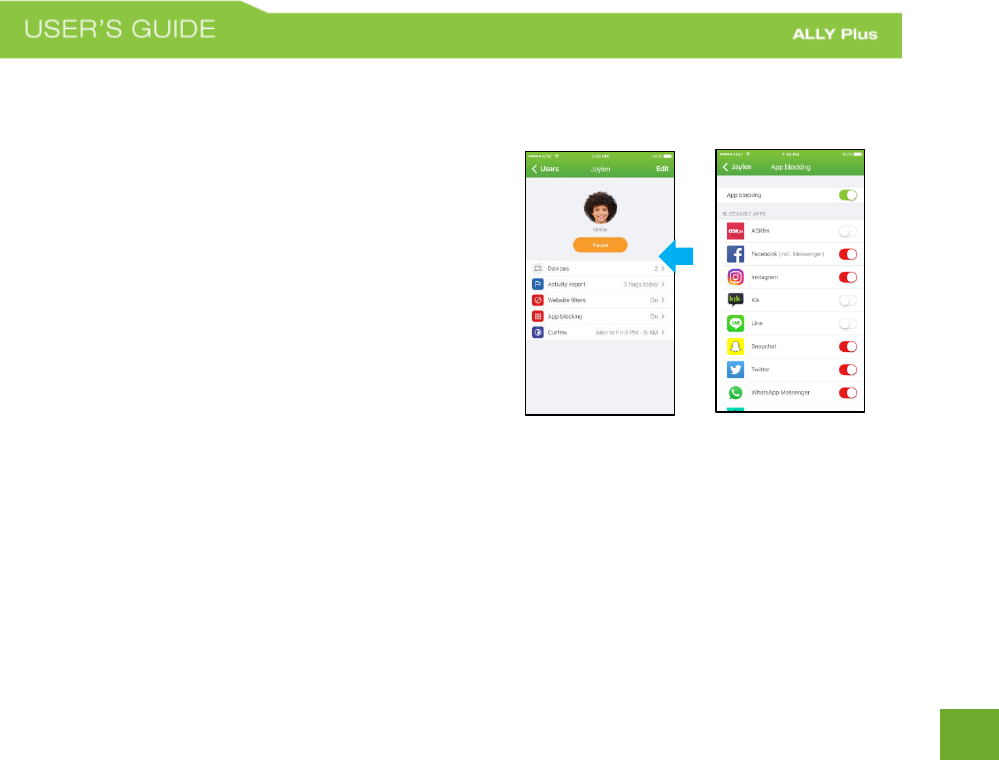
37
App Blocking
ALLY lets you to block apps and services for each family member. Blocked Apps will not be able to connect to
internet until unblocked.
To Block apps and services
a) On the User Profile screen, tap App Blocking.
b) Toggle the App Blocking switch to turn on.
c) Switch toggles on to block apps and services.
Switch toggles off to allow.
d) Tap the Back button when finished.
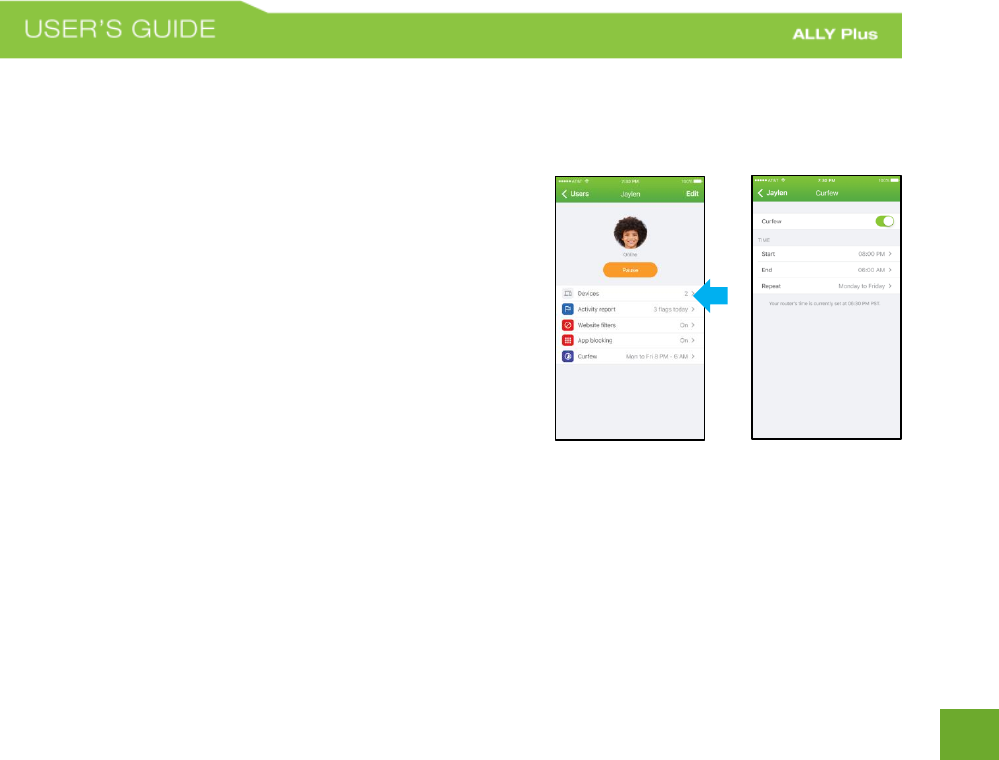
38
Curfew
ALLY lets you set individual Wi-Fi schedules for when you want your family members to be offline: dinners,
homework, bedtime, etc.
To set a Curfew
a) On the User Profile screen, tap Curfew.
b) Toggle the Curfew switch to turn on.
c) Set a start time for when you want to stop Internet
access.
d) Set an end time for when you want to resume
Internet access.
e) To make this Curfew repeat, tap Repeat and choose
the days of the week you want the Curfew to be
active.
f) Tap the back button when finished.
You can override a Curfew by tapping Resume on the User Profile screen. This will resume Internet access
until the next scheduled Curfew.

39
Advanced settings
If you want to apply more advanced network settings on your ALLY for example port forwarding, you will
need access ALLY web interface by opening http://setup.ampedwireless.amped.com in your PC or tablet
browser.
If ALLY was setup using the app, then you can find the access code required to access web UI in settings >
advanced settings.
Update firmware
ALLY app will automatically alert you if a software update is available when you use the app. Please follow
the instructions in the app so you can always keep your ALLY up to date.
To make sure you enjoy the latest features and that ALLY stays secure, please always keep your ALLY app
and router software up to date.
Erase data and disconnect ALLY
This allows you to disconnect your ALLY account with your ALLY router. This will also delete all your
personal data from the cloud for example profiles, devices information.
This does not Reset your router. If you want to wipe your data from the router, you must reset the router
using the reset button on the router.

40
Therefore, if you are returning or replacing your ALLY, we recommend that you first “Erase data and
disconnect ALLY” from the app but then also reset the router.
Privacy settings
We care about your privacy and want you to have more control over how we collect and use your data.
Please read our privacy policy to understand what data we collect, why we collect it, and how we use it. In
addition, we have also provided you with a few choices in the privacy settings section: use of third party
analytics in our app and opting out of ALLY related product updates.
To read the ALLY App Terms of Service, visit: www.chimewifi.com/tos
To read the ALLY App Privacy and Cookie Policy, visit: www.chimewifi.com/privacypolicy

41
WEB MENU
The web menu can be used to access advanced features that may not be configurable via the ALLY app. These
features include port forwarding, firewall settings, quality of service and more.
How to access the Web Menu:
a) If you are already using the ALLY app, open the ALLY app
and go to the settings menu from the home page. Tap
on Advanced Settings for further instructions and to
obtain the access code to log in.
b) If you have never used the ALLY app, connect to the
Wi-Fi network of the router, open a web browser and go
to: http://setup.ampedwireless.com
Note: Some features may not be accessible if the ALLY router is in use with an ALLY app account. These
features will have greyed out boxes and cannot be selected.

42
Welcome to the Dashboard
The Dashboard provides you with information regarding
your internet connection and basic router settings. From
here you can enable or disable guest networks, have a quick
glance at what devices are connected to your Router and
enable or disable website blocking features. For more
advanced settings click on More Settings to navigate
through the configuration menu.
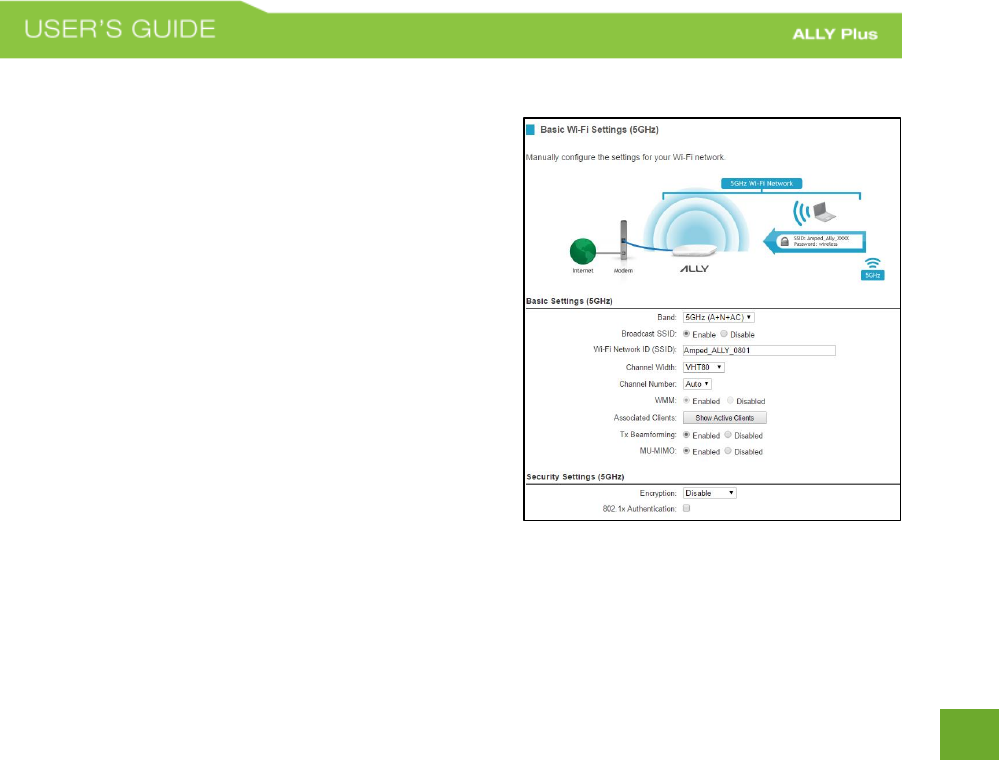
43
Wi-Fi Settings: Basic Settings (5.0GHz)
The Basic Settings page allows you to adjust settings for your
5GHz local wireless network.
Disable 5.0GHz Wireless Connections: Disabling will turn off
all 5GHz Wi-Fi activity. Users will no longer be able to
connect wirelessly to your 5GHz network.
Band: Select the compatible Wi-Fi standard and speed for
your wireless network.
Broadcast SSID: Selecting Disable Broadcast SSID will hide the
visibility of the router’s 5GHz network SSID. Users must
manually enter the SSID to connect.
Wi-Fi Network ID (SSID): The name of your 5GHz wireless
network.
Channel Number: Wi-Fi networks operate on specific
wireless channels. Some network channels may have more interference than others. If your performance is
unstable, try a different channel number. If you are using a repeater with this network, it is recommended you
set a static channel, instead of using "Auto".

44
WMM: Prioritizes multimedia data over the wireless network.
Associated Clients: Shows the active users connected wirelessly to your 5GHz network.
Tx Beamforming: Enable Beamforming capabilities with Beamforming capable devices to increase Wi-Fi
connection reliability and range.
MU-MIMO: Enable or disable Multi-User MIMO. MU-MIMO enables the router to send data to multiple
devices (devices must be MU-MIMO capable) simultaneously thereby increasing overall network performance
and speed.
Security Settings: Change the type of wireless security settings for your 5.0GHz Wi-Fi Network.
Encryption: Select the encryption type for your Wi-Fi Network.
Pre-Shared Key: The password for your Wi-Fi Network. This is the key used by devices connecting to your
Extended Network.
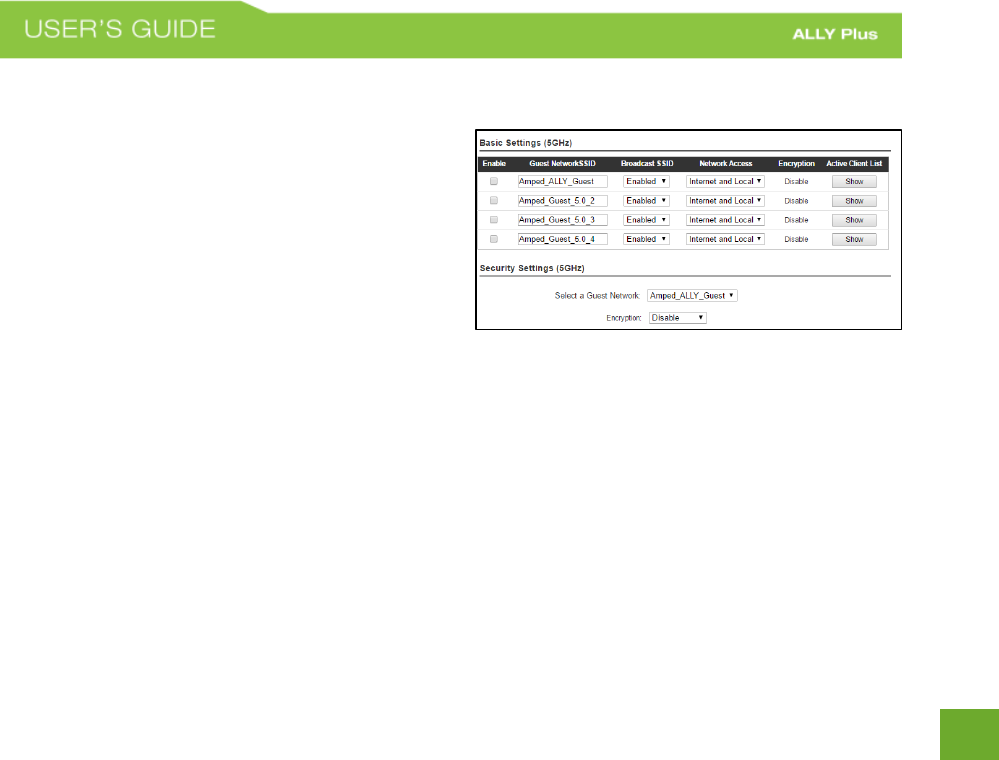
45
Wi-Fi Settings: Guest Networks (5.0GHz)
Click “Enable” to create a Guest Network. Guest
Networks provide a separate wireless network, with
unique settings for users to connect to.
SSID: This is the name of your Guest Network.
Broadcast SSID: Disable to hide your SSID from public
view. Users will need to manually enter the SSID into
their wireless software interface to connect.
Network Access: Restrict users connecting to your
Guest Network to Internet access only or both local network and Internet access.
Active Client List: View all computers and network devices that are connected to your Guest Network
wirelessly.
Security Settings: Change the type of wireless security settings for your Guest Networks by selecting the
specific Guest Network SSID from the drop down menu.
Encryption: Select the encryption type for your Guest Network.
Pre-Shared Key: The password for your Guest Network. This is the key used by devices connecting to your
Guest Network.
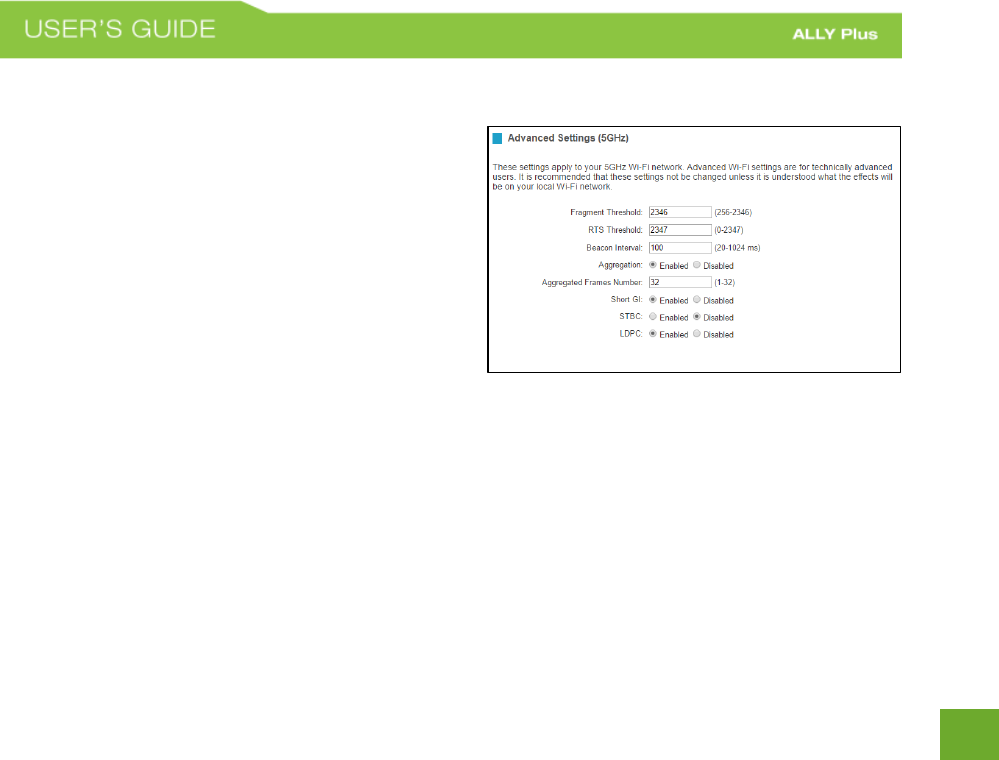
46
Wi-Fi Settings: Advanced Settings (5.0GHz)
Advanced Wireless Settings should only be adjusted by
technically advanced users. It is not recommended that
novice users adjust these settings to avoid degrading
wireless performance.
Fragment Threshold: The default and recommended
setting is at 2346, meaning the Router will never
fragment any frames that it sends to wireless users.
RTS Threshold: Adjusts the size of RTS data packets.
Lower values reduce throughput, but allow the system to
recover quicker from interference/collisions. Higher
values provide the fastest throughput.
Beacon Interval: Indicates the frequency interval of the beacon. A beacon is a packet broadcast by the router
to synch the wireless network.
STBC: Space Time Block Coding improves reception by coding the data stream in blocks.
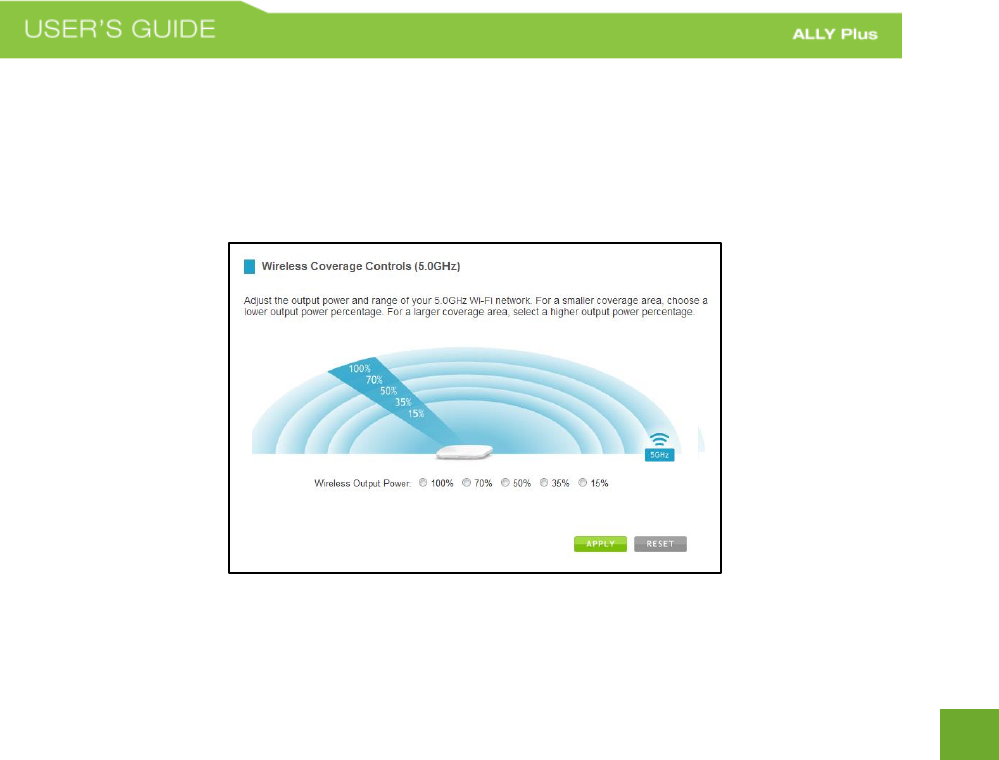
47
Wi-Fi Settings: Wireless Coverage (5.0GHz)
Adjust the output power of the Router to control the coverage distance of your 5GHz wireless network. For a
smaller coverage area, you can select a lower output power. For the maximum wireless coverage, select the
100% selection.
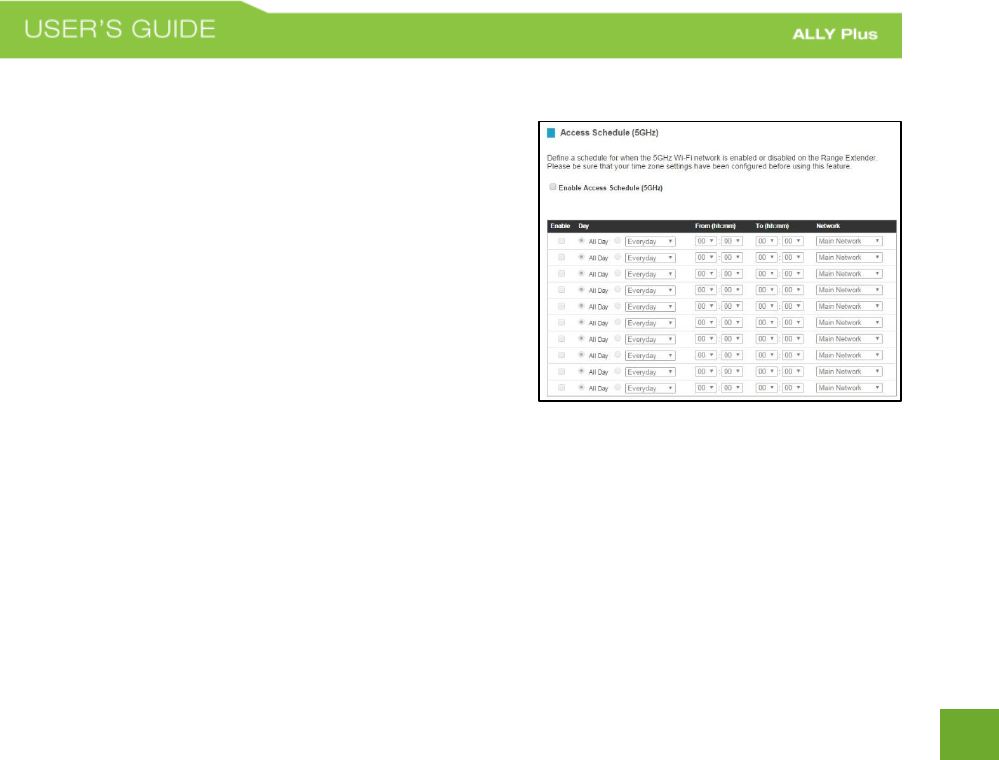
48
Wi-Fi Settings: Access Schedule (5.0GHz)
Access Schedules will enable or disable your 5.0GHz wireless
access at a set time based on your predefined schedule. This
feature is often used for restricting access to all users (such as
children, employees, guests) during specific times of the day for
parental control or security reasons.
a. Enable Access Schedule.
b. Select which days you wish for your Wi-Fi to be
available.
c. Select the time frame during that day that you wish for
Wi-Fi to be available.
d. Select the Network that you wish to apply these settings to.
e. Apply Changes.
Note: Make sure you have already configured your System Clock in order for your schedule to work correctly.
Time Zone Settings can be adjusted from the web menu under Management > Time Zone Settings.
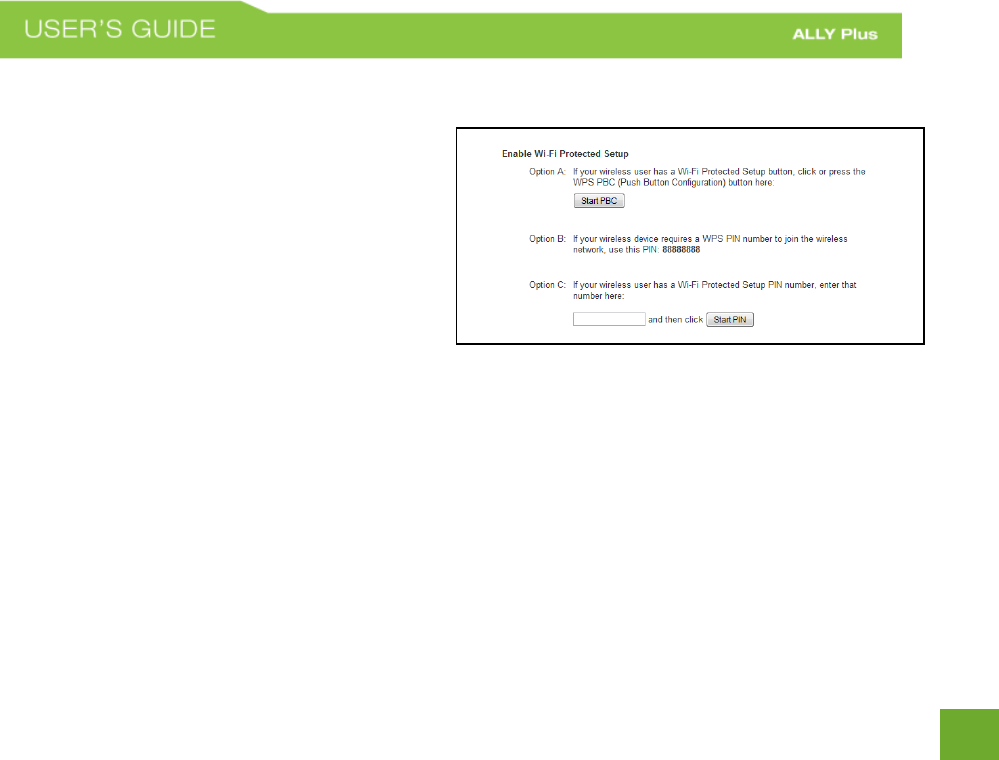
49
Wi-Fi Settings: Wi-Fi Protected Setup – WPS (5.0GHz)
WPS is a Wi-Fi feature created to make Wi-Fi setup
simple and easy. Some wireless routers and adapters
support this feature with varying names (i.e. one
touch setup or WPS).
You may enable WPS setup here by selecting the type
of WPS setup you wish to use. The Router supports
all types of WPS setup:
Option A: Push button: You may push the WPS button on the web menu or use the physical button on the
back of the Router.
Option B: PIN: Some wireless devices use PIN number to access wireless network. If your wireless device
requests for a PIN number, use the PIN code located here.
Option C: Enter PIN: Some wireless devices require that you use a PIN number to add them to the wireless
network. If your wireless device has a PIN number locate the number and enter in the field, then press Start
Pin.
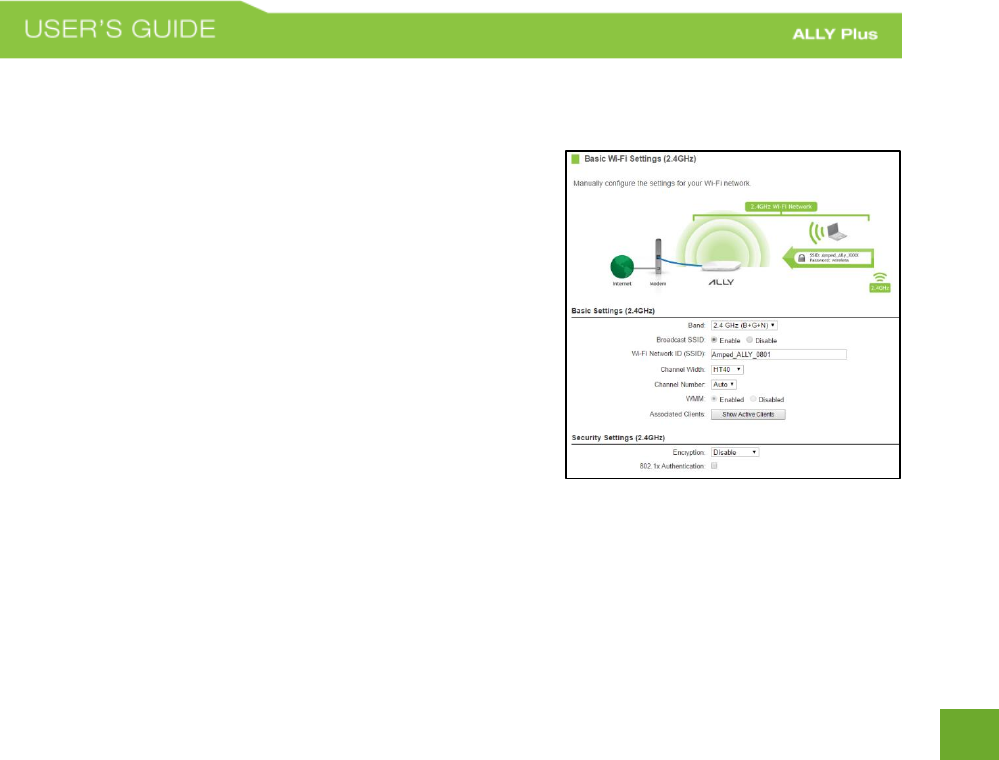
50
Wi-Fi Settings: Basic Settings (2.4GHz)
The Basic Settings page allows you to adjust settings for your
2.4GHz local wireless network.
Disable 2.4GHz Wireless Connections: Disabling will turn off all
2.4GHz Wi-Fi activity. Users will no longer be able to connect
wirelessly to your 2.4GHz network.
Band: Select the compatible Wi-Fi standard and speed for your
wireless network.
Broadcast SSID: Selecting Disable Broadcast SSID will hide the
visibility of the router’s 2.4GHz network SSID. Users must manually
enter the SSID to connect.
Wireless Network ID (SSID): The name of your 2.4GHz wireless
network.
Channel Number: Wi-Fi networks operate on specific wireless channels. Some network channels may have
more interference than others. If your performance is unstable, try a different channel number. If you are
using a repeater with this network, it is recommended you set a static channel, instead of using "Auto."

51
WMM: Prioritizes multimedia data over the wireless network.
Associated Clients: Shows the active users connected wirelessly to your 2.4GHz network.
Security Settings: Change the type of wireless security settings for your 2.4GHz Wi-Fi Network.
Encryption: Select the encryption type for your Wi-Fi Network.
Pre-Shared Key: The password for your Extended Network. This is the key used by devices connecting to your
Wi-Fi network.
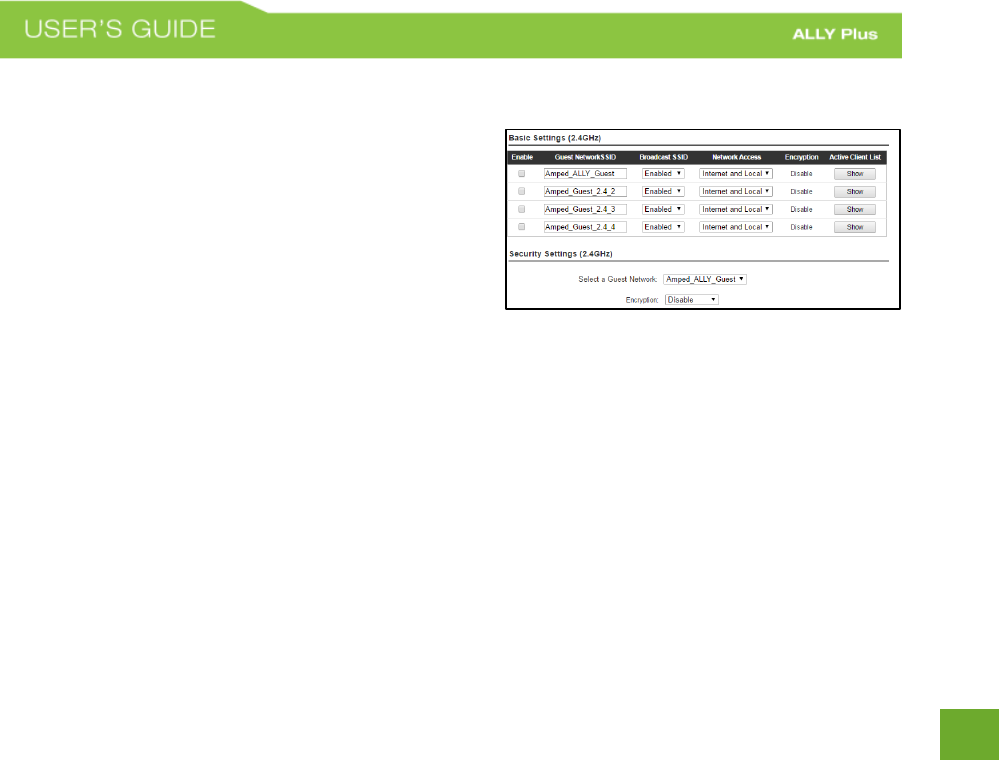
52
Wi-Fi Settings: Guest Networks (2.4GHz)
Click “Enable” to create a Guest Network. Guest Networks
provide a separate wireless network, with unique settings
for users to connect to.
SSID: This is the name of your Guest Network.
Broadcast SSID: Disable to hide your SSID from public view.
Users will need to manually enter the SSID into their
wireless software interface to connect.
Network Access: Restrict users connecting to your Guest Network to Internet access only or both local network
and Internet access.
Active Client List: View all computers and network devices that are connected to your Guest Network
wirelessly.
Security Settings: Change the type of wireless security settings for your Guest Networks by selecting the
specific Guest Network SSID from the drop down menu.
Encryption: Select the encryption type for your Guest Network.
Pre-Shared Key: The password for your Guest Network. This is the key used by devices connecting to your
Guest Network.
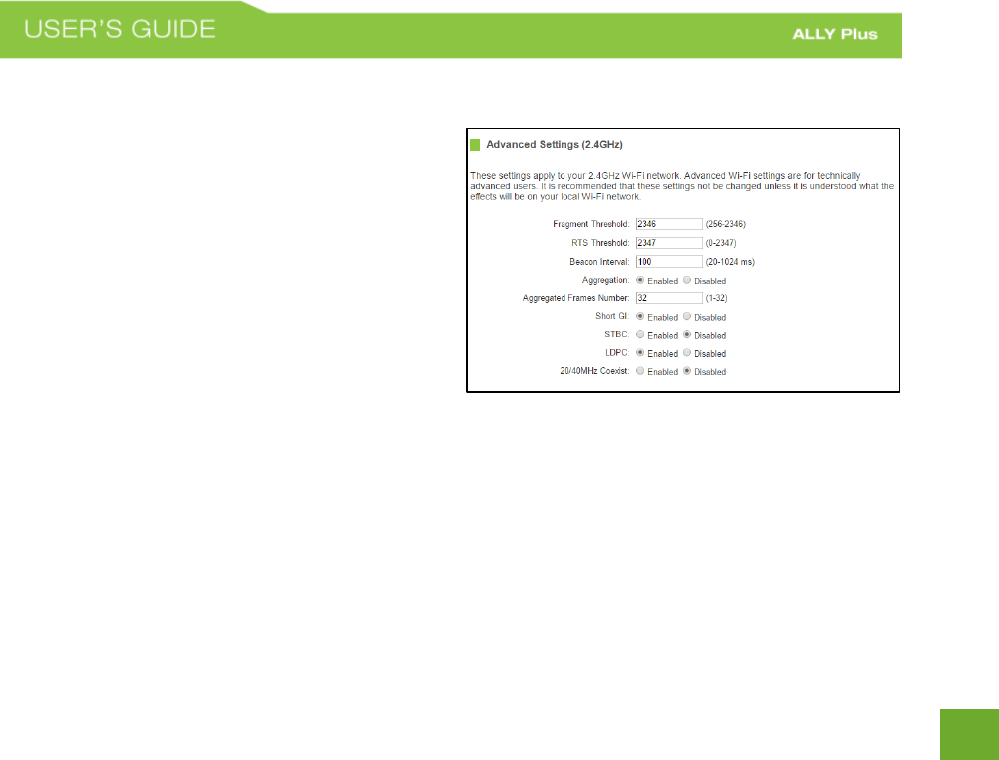
53
Wi-Fi Settings: Advanced Settings (2.4GHz)
Advanced Wireless Settings should only be adjusted by
technically advanced users. It is not recommended
that novice users adjust these settings to avoid
degrading wireless performance.
Fragment Threshold: The default and recommended
setting is at 2346, meaning the Router will never
fragment any frames that it sends to wireless users.
RTS Threshold: Adjusts the size of RTS data packets.
Lower values reduce throughput, but allow the system
to recover quicker from interference/collisions. Higher
values provide the fastest throughput.
Beacon Interval: Indicates the frequency interval of the beacon. A beacon is a packet broadcast by the router
to synch the wireless network.
STBC: Space Time Block Coding improves reception by coding the data stream in blocks.

54
Wi-Fi Settings: Wireless Coverage (2.4GHz)
Adjust the output power of the Router to control the coverage distance of your 2.4GHz wireless network. For
a smaller coverage area, you can select a lower output power. For the maximum wireless coverage, select the
100% selection.

55
Wi-Fi Settings: Access Schedule (2.4GHz)
Access Schedules will enable or disable your 2.4GHz wireless
access at a set time based on your predefined schedule.
This feature is often used for restricting access to all users
(such as children, employees, guests) during specific times
of the day for parental control or security reasons.
a. Enable Access Schedule.
b. Select which days you wish for your Wi-Fi to be
available.
c. Select the time frame during that day that you wish
for Wi-Fi to be available.
d. Select the Network that you wish to apply these settings to.
e. Apply Changes.
Note: Make sure you have already configured your System Clock in order for your schedule to work correctly.
Time Zone Settings can be adjusted from the web menu under Management > Time Zone Settings.
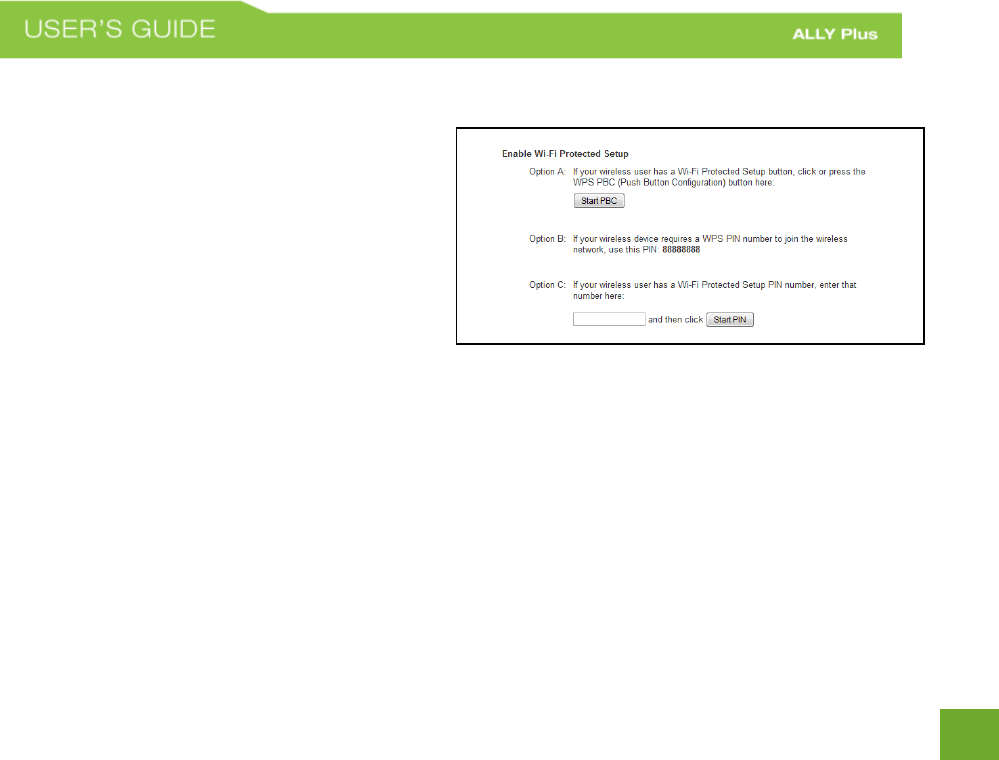
56
Wi-Fi Settings: Wi-Fi Protected Setup – WPS (2.4GHz)
WPS is a Wi-Fi feature created to make Wi-Fi setup
simple and easy. Some wireless routers and adapters
support this feature with varying names (i.e. one
touch setup or WPS).
You may enable WPS setup here by selecting the type
of WPS setup you wish to use. The Router supports
all types of WPS setup:
Option A: Push button: You may push the WPS button on the web menu or use the physical button on the
back of the Router.
Option B: PIN: Some wireless devices use PIN number to access wireless network. If your wireless device
requests for a PIN number, use the PIN code located here.
Option C: Enter PIN: If your wireless device has a PIN number, locate the number and enter it into the field.
Press Start PIN when ready.
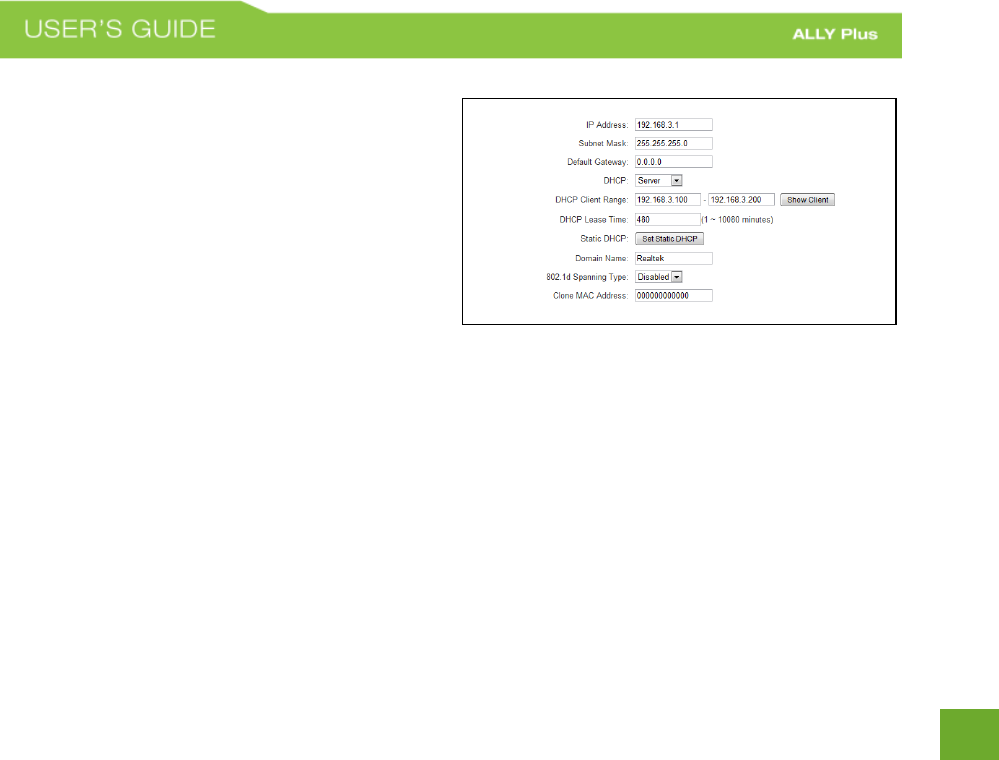
57
Network Settings: Local Network (LAN)
These settings are for your local network only and do
not apply to your Internet / ISP connection.
IP Address: The IP address of the Router.
Subnet Mask: The subnet of the Router.
Default Gateway: The access point to another network.
DHCP: Each network device on your local network will have its own IP Address. The DHCP server automatically
assigns the IP addresses to each device connected to your network. Disabling DHCP will require that each
device on your network be assigned a manual or static IP address.
DHCP Client Range: The range of IP addresses provided by the DHCP server is defined by this field. You can
limit how many IP addresses are used in your network by setting a smaller or larger range.
DHCP Lease Time: The amount of time each device is given a specific IP is decided by the DHCP lease time.
After the Lease Time expires, the DHCP server will assign another IP address to the device.

58
Set Static DHCP: This allows specific devices to be given a specific IP address each time the device connects to
the network. The DHCP server will always assign the same IP address to the same device. This feature is often
used for shared devices such as network printers or servers.
802.1d Spanning Type (STP): A network protocol that ensures a loop-free topology for networks that have
Ethernet bridges. The STP prevents bridge loops and allows a network design to include redundant links to
provide automatic backup paths if active links fails.
Clone MAC Address: The Router can use a MAC address that you define as its own. This is often used when an
Internet Provider only authorizes one MAC address to access the Internet. Cloning the MAC address will make
it so that the cloned MAC address is the only MAC address seen by the Internet Provider.
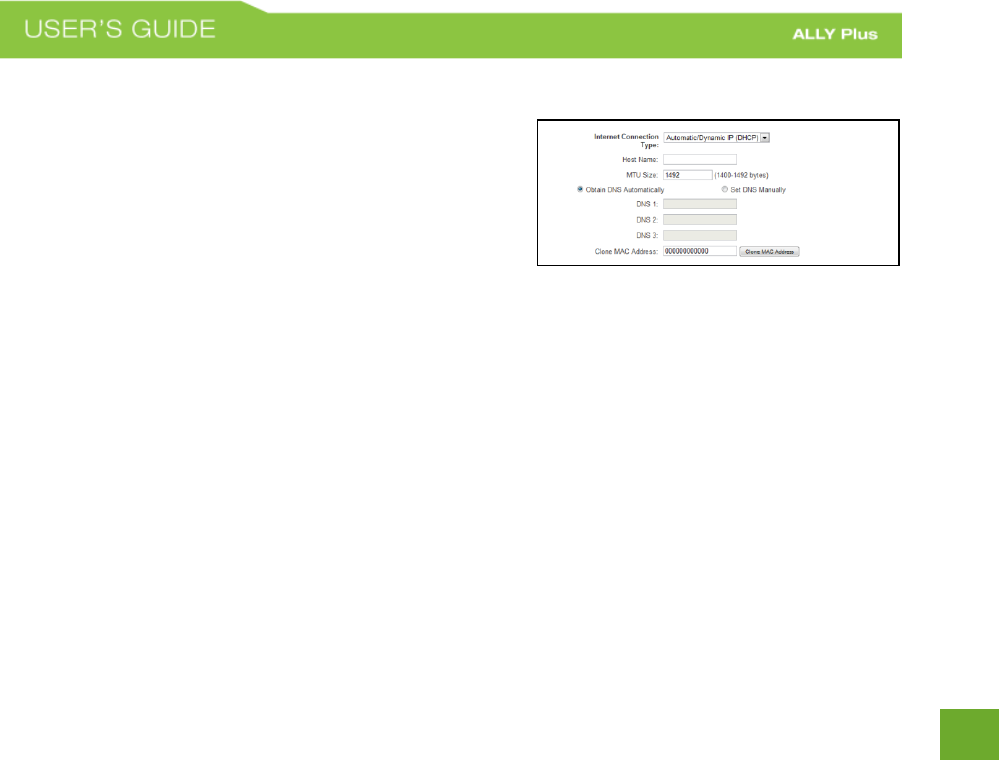
59
Network Settings: Internet Network (WAN)
The Basic Setup Wizard will assist you in setting up your
Internet connection. However, in the case that you wish to
adjust settings manually, the options on this page provides you
with the tools to do this easily.
Select your Internet Connection type from the drop down
menu:
Manual IP (Static): For Internet connections where the Internet provider does not provide you with an IP
address automatically. If you know the IP address and DNS settings that your Internet provider uses, select this
option.
Automatic/Dynamic (DHCP): This is the configuration type most often used by Internet providers. Automatic
configurations are used by both DSL and Cable as well as other providers. Under the Automatic Configuration
method, the Internet provider will assign your router an Internet IP address automatically.

60
If for some reason you do not get an IP address and you know that your Internet provider uses DHCP, try
resetting your modem. Remove the power adapter from the modem as well as the backup battery (if
available). Wait about 30 seconds and then power the modem back on. You can run through the Basic Setup
Wizard again to see if that fixes your Internet connection issues.
PPPoE connections normally requires login information. If you do not know the settings for your PPPoE
connection, please contact your Internet provider.
PPTP and L2TP connections requires login information as well as IP address settings. If you do not know the
settings for your PPTP / L2TP connection, please contact your Internet provider.
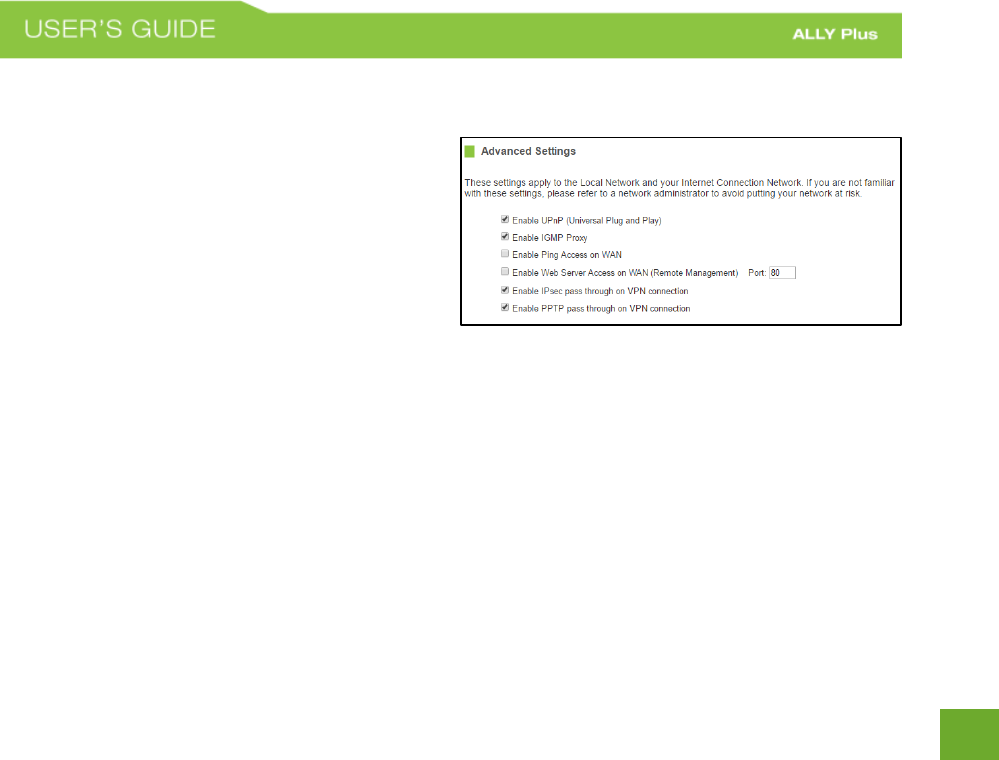
61
Network Settings: Advanced Settings
These settings apply to the Local Network and your
Internet Connection Network. If you are not familiar
with these settings, please refer to a network
administrator to avoid putting your network at risk.
Enable uPnP: Universal Plug and Play is a network
feature that allows uPnP enabled devices to “just
work” with each other when connected to the same
network. UPnP can work across different network media, such as an Ethernet connection or wireless
connection. With UPnP enabled, network devices may change security settings within the Router’s firewall to
allow access over the Internet. By default, UPnP is disabled to avoid exposing your network to security issues.
Enable IGMP Proxy: Internet Group Management Protocol is a communication protocol used by hosts and
routers on the network to establish multicast group memberships. IGMP Proxy is typically used to implement
multicast routing and commonly used when advanced protocols such as PIM is not suitable.
Enable Ping Access on WAN: Allows users to ping the WAN interface IP address from the Internet.
Enable Web Server Access on WAN (Remote Management): Allows access to the Web Menu over the Internet.

62
Enable IPsec pass through on VPN connection: Allows the IP security protocol suite to pass through on a VPN
connection.
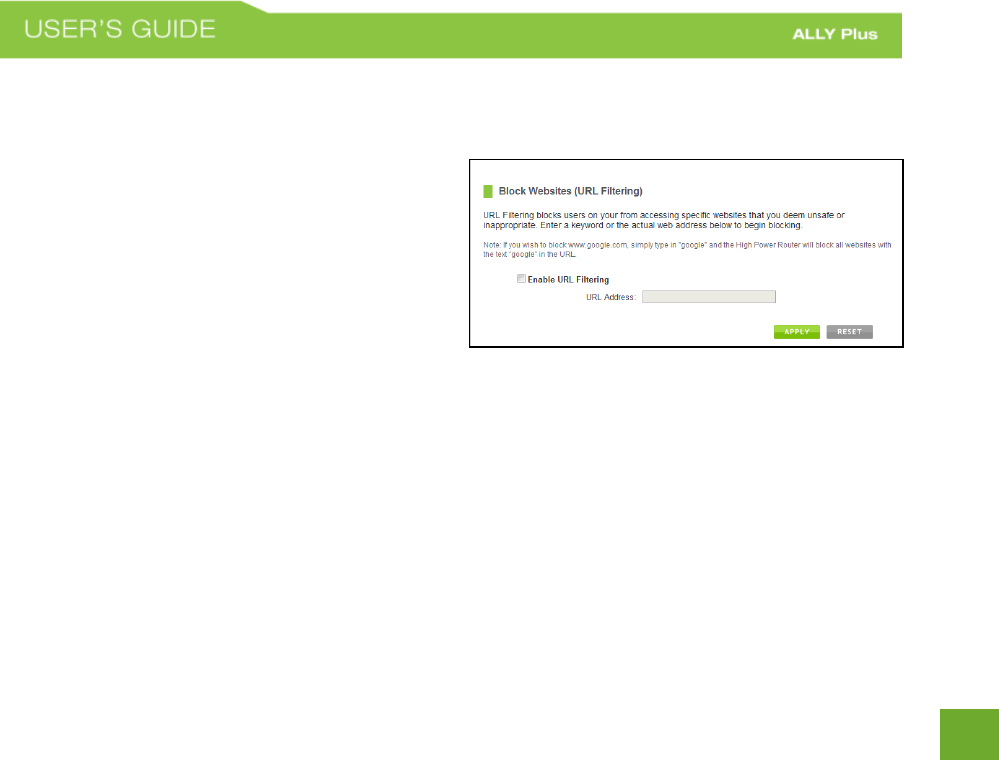
63
Security Features: Block Websites
To block a website, you must first enable URL filtering.
After it has been enabled, you can begin adding as
many websites as you wish into the URL Address field.
Note: If you wish to block www.google.com, simply
type in "google" and the Router will block all websites
with the text "google" in the URL.
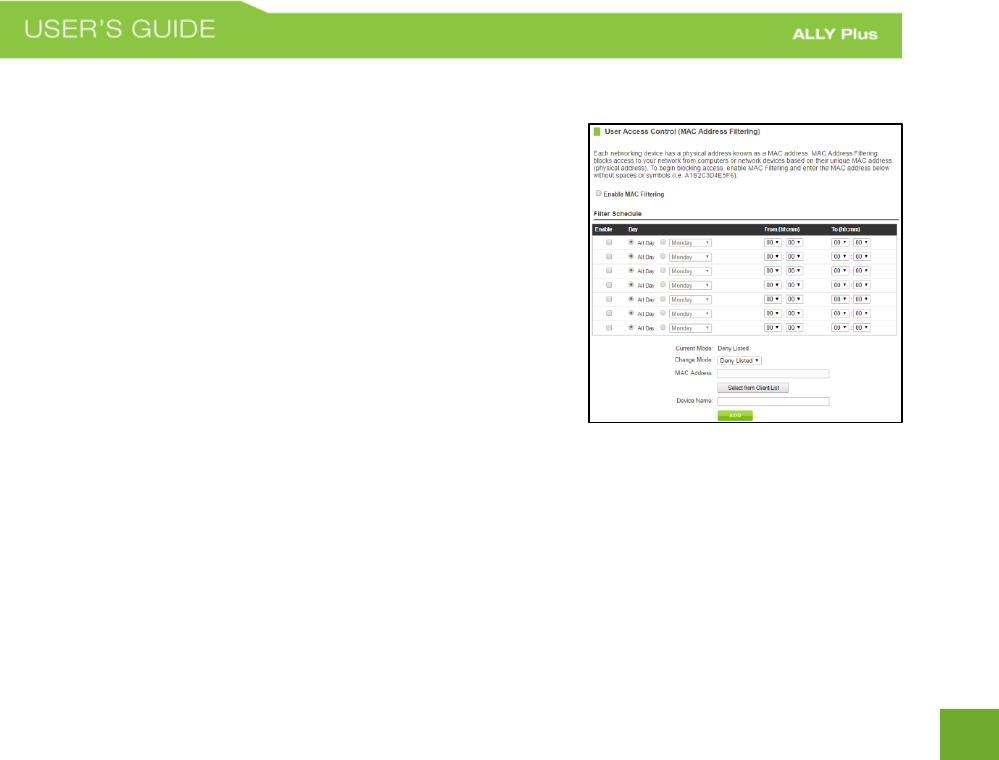
64
Security Features: User Access (MAC Address Filtering)
User Access allows you to deny access or allow access to specific
users connecting to the network. Each networking device has a
unique address called a MAC address (a 12-digit hex number).
By inputting the MAC address into the field, you can define whether
that device is allowed into your network or not allowed.
A MAC Address may sometimes be referred to as a Physical Address.
Most networking devices have their MAC Address located on a label
on the actual device.
For Windows computers with internal networking adapters, the MAC
Address can be found by viewing the Network Connection Details of the network adapter. The MAC Address
will be listed as the Physical Address.
Be sure to enter the MAC Address without any symbols. For example, a MAC Address of 78-DD-78-AA-78-BB
would be entered as 78DD78AA78BB.
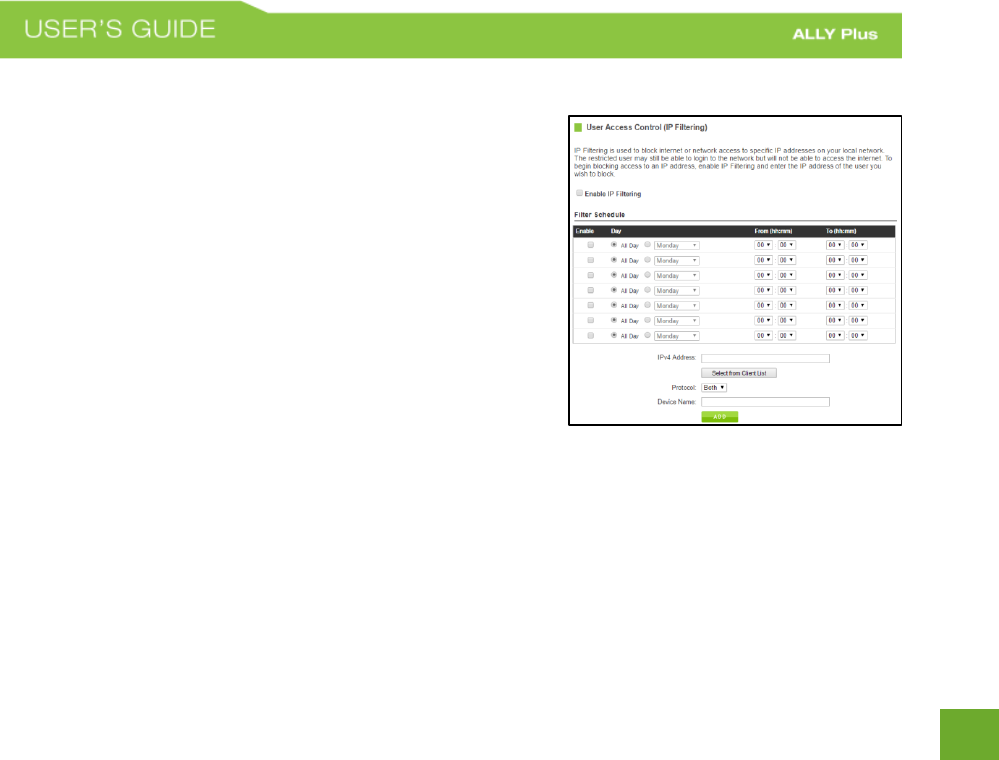
65
Security Features: User Access (IP Address Filtering)
User Access (IP Filtering) is similar to User Access (MAC filtering)
except that the Router uses the local IP address to filter the specific
data from the specified network protocol. For example, if you
chose to block TCP data packets from a specific computer, you
would need to figure out what that device's IP address is and select
TCP from the Protocol drop down menu.
If you are not sure which Protocol to filter, select "Both" as your
Protocol selection.
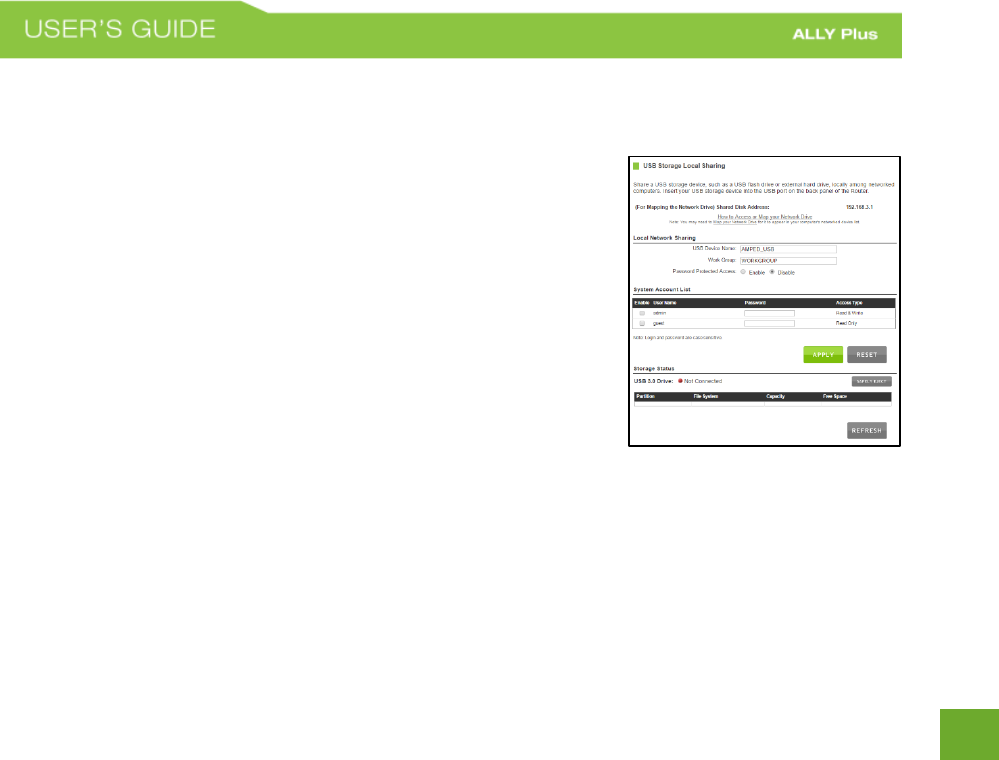
66
USB Storage: Local Sharing
Share USB storage devices with computers on the local network of the
Router.
Insert a USB storage device, such as a flash drive or external hard drive, to
the USB port on the back panel of the Router and follow the directions
below for your operating system. The computer must be connected to the
router to access the storage device. You may also want to Map the
Network Drive so it shows up as a standard drive on your computer for
easier access.

67
Windows 7 and Vista
To access the drive from your Windows desktop:
Note: If the USB drive does not appear automatically under your Networked devices (Windows 7, Vista or Mac OS X), you will need to Map
the Network Drive.
a) Click the Start button.
b) Click Computer.
c) On the Computer page, the drive should appear on the left hand column under Network as
AMPED_USB.
To Map the Network Drive:
a) Click the Start button.
b) Click Computer.
c) Click Map Network Drive from the top bar.
d) Select a drive letter (any), then enter in the folder field either of the following depending on which
USB port is being used:
\\AMPED_USB\usb3\ or \\router’s LAN IP address\usb3\
e) If the drive fails to open, click browse and locate AMPED_USB under Network.

68
Windows XP
To access the drive from your Windows desktop:
Note: If the USB drive does not appear automatically under your Networked devices (Windows 7, Vista or Mac OS X), you will need to Map
the Network Drive.
a) Click the Start button.
b) Click My Computer.
c) Click on My Network Places and locate the drive named AMPED_USB.
To Map the network drive:
a) Click the Start button.
b) Right Click My Computer and select Map Network Drive.
c) Select a drive letter (any), then enter in the folder field either of the following depending on which
USB port is being used:
\\AMPED_USB\usb3\ or \\router’s LAN IP address\usb3\
d) If the drive fails to open, click browse and locate AMPED_USB under Network.

69
Mac OS X
To access the drive from your Mac desktop:
Note: If the USB drive does not appear automatically under your Networked devices, you will need to Map your Network Drive
(Instructions below).
a) Open Finder.
b) On the left hand menu, under Shared, click AMPED_USB.
To Map the network drive:
a) Open Finder.
b) From the menu on the top of the desktop, select Go.
c) Select Connect To Server from the drop down menu.
d) Enter the address of the network drive: smb://amped_usb/usb3
e) Then click Connect.
If the network drive does not appear on your Mac desktop, follow these steps:
Open Finder.
i. Select Preferences from the drop down menu.
ii. Check show "Connected Servers".
iii. The drive should now appear on your desktop.
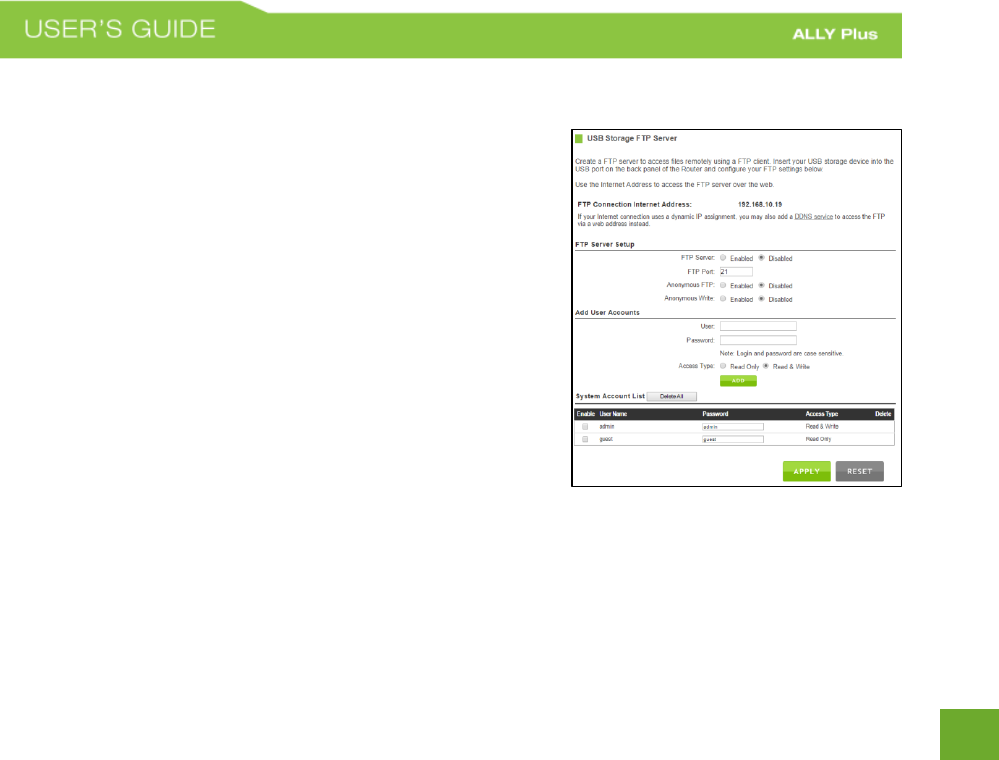
70
USB Storage: FTP Server
Share USB storage devices with computers remotely over the
Internet. A FTP server allows you to access files through the use of
an FTP client remotely over the Internet.
Insert a USB storage device, such as a flash drive or external hard
drive, to the USB port on the back panel of the router.
From the USB Storage/FTP Server page of the web menu, enable
the FTP Server feature
a) Enable the FTP Server
b) Select whether you wish to have anonymous access or secured
access.
c) Open your FTP client software (not provided) and create a new
FTP connection.
d) Enter the Internet Address for the router as the IP address for your FTP connection. When prompted
enter your login information to access the USB Storage device remotely.
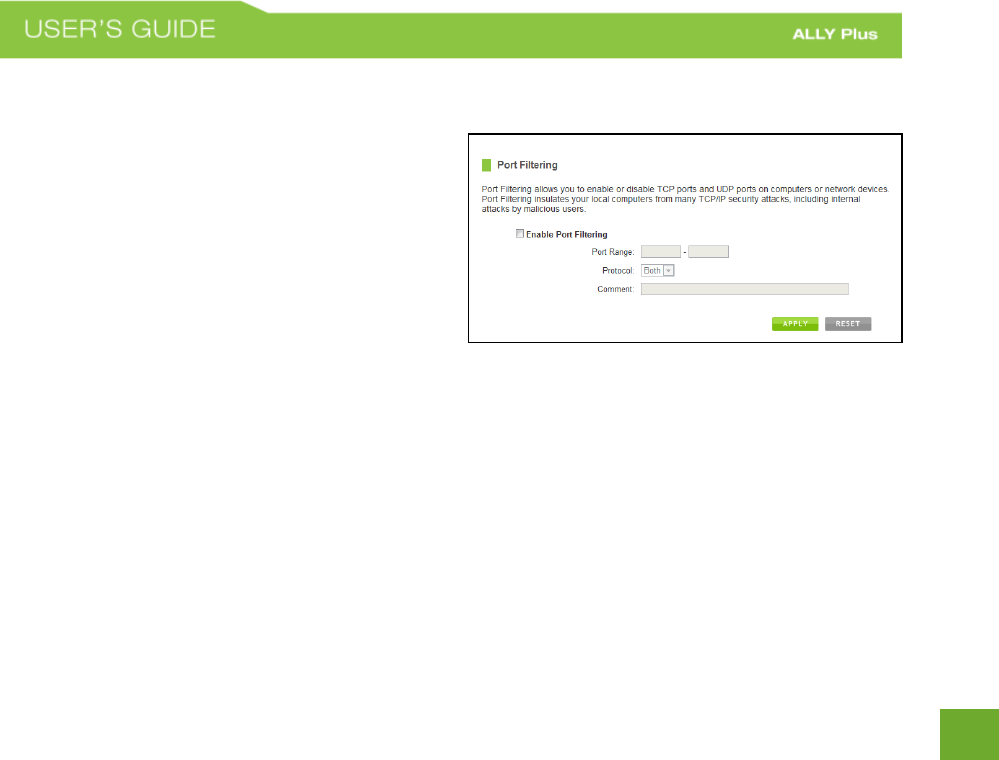
71
Firewall Settings: Port Filtering
Port Filtering is a security measure that prevents users
from using specific ports for reasons other than what
those ports were originally intended for. For example,
TCP port 21 is traditionally used for FTP. However,
there is nothing stopping a user from using port 21 for
purposes other than FTP access. By enabling Port
Filtering on TCP port 21, only FTP communications
would be allowed. No other types of communication
would be allowed on this port.
Hackers may sometimes scan for all open ports on your network as a method of hacking into your network.
Port Filtering and other firewall features help to prevent this from happening.
To set up Port Filtering, select a range of ports you wish to filter. If you are trying to filter a single port, enter
the port number twice. (For example, Port 21: 21 – 21) Select the Protocol of the port you are filtering. If you
do not know what protocol you wish to filter, select “Both.”
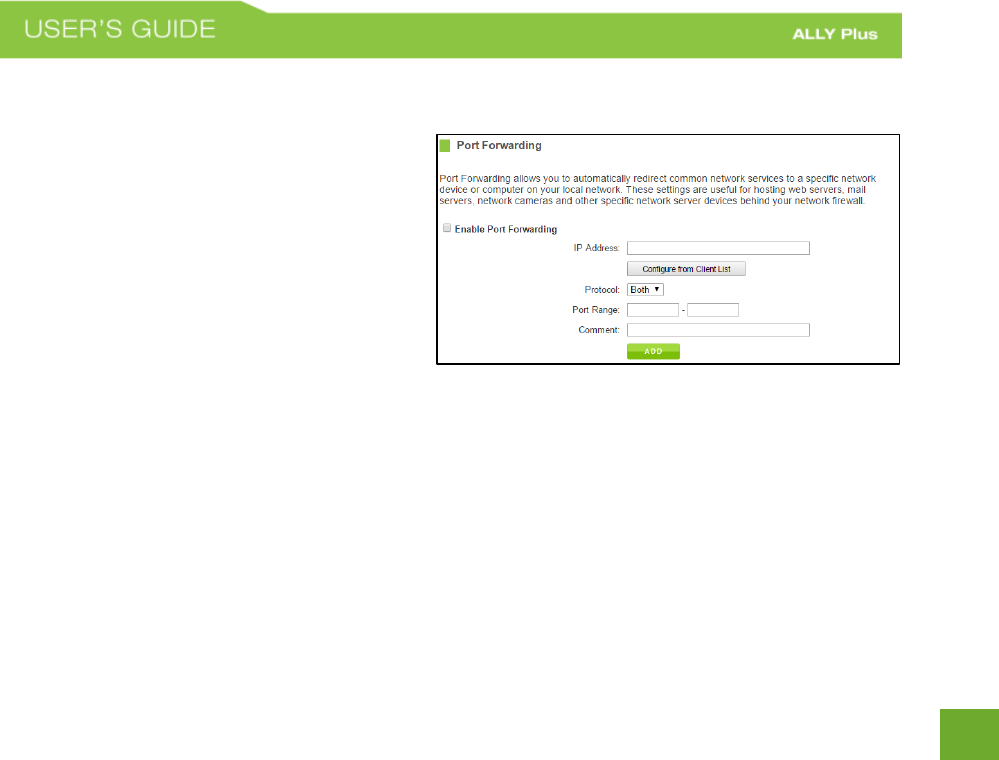
72
Firewall Settings: Port Forwarding
Port Forwarding is a rule that tells the Router that
if a specific type of request comes in on a specific
port, then that request should be forwarded to a
specific device on the private network.
Port Forwarding is often used for setting up
servers, cameras and other devices that require
remote access.
Enable Port Forwarding: Enables designated ports
to begin forwarding.
IP Address: The IP address of the device behind the Firewall that is being designated for Port Forwarding.
Protocol: Select UDP, TCP or Both for the protocols to be forwarded.
Port Range: Select a range of ports for the designated IP address that you wish to be forwarded.
Comment: Create a name that you can use to easily identify this Port Forwarding entry.
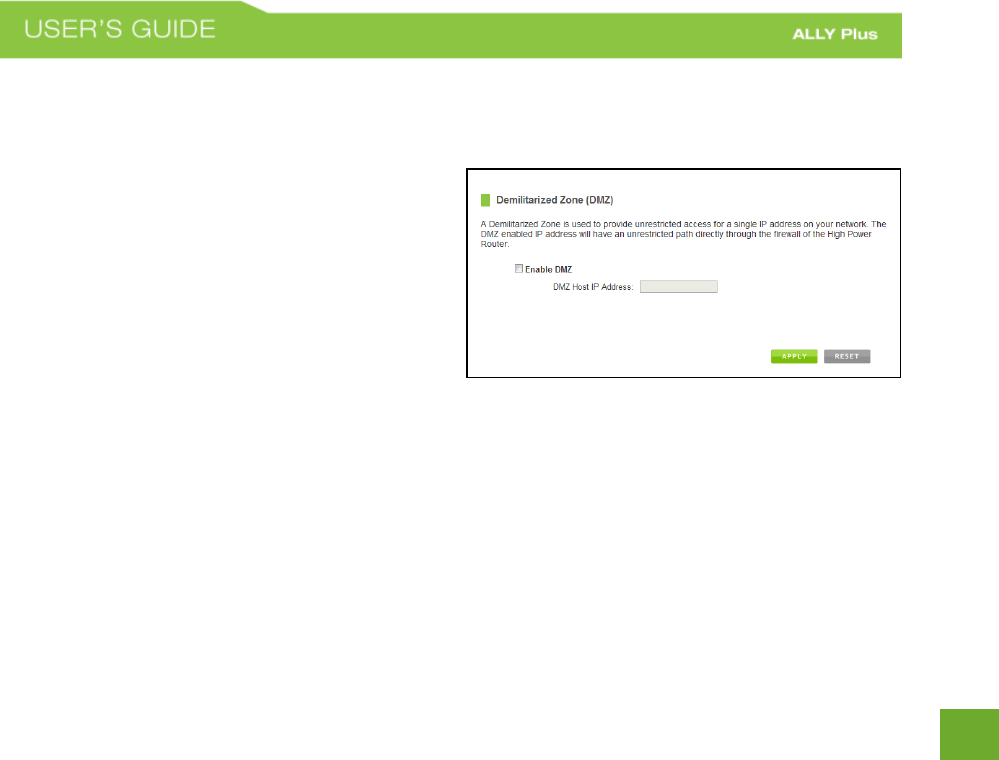
73
Firewall Settings: DMZ (Demilitarized Zone)
A DMZ is a network location or IP Address that is not
protected by the firewall. When enabling DMZ, it is
important to note that the device on the IP Address
designated as part of the DMZ does not have any
protection from the Router’s firewall. The device’s
only security would be those built into the operating
system.
As a general safety rule, devices placed on the DMZ should not have any other network connections to any
other devices.
Enable DMZ: Enables the Demilitarized Zone.
DMZ Host IP Address: The designated IP Address of the network device to have unrestricted access through
the Router’s Firewall.
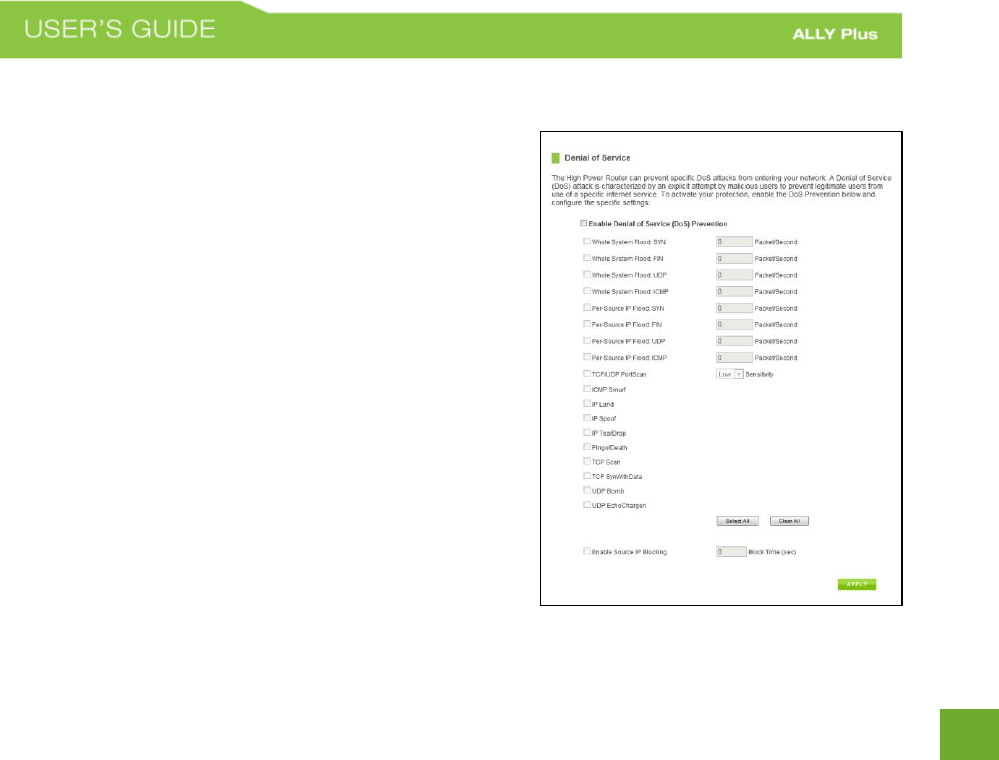
74
Firewall Settings: Denial of Service
A Denial of Service attack is an attempt by a user (or users) to
make a server’s or network’s services unavailable. The user
sends a server multiple requests with false return addresses.
The server will attempt to respond by sending a request back to
the user; however, since the address is false, the server will
wait for a response before closing the connection. When
multiple requests like this occur, servers may often get
overloaded with too many requests and stop functioning
altogether. This is a typical DoS attack, although DoS attacks
may not be limited to this type of attack.
The Router can assist in preventing these types of attacks by
scanning the network for patterns of activity that represent DoS
attacks. If a pattern comes in frequently, the Router can
attempt to block messages containing that pattern and thus
protect the server from becoming overloaded and
unresponsive.

75
Quality of Service
QoS prioritizes and guarantees network performance for a specific application for an IP Address range or MAC
Address. You can also enter only an IP address or MAC address without selecting an application if you wish to
prioritize all traffic for a specific device.
QoS is often used for applications that require steady bandwidth. Common applications include VoIP phones,
video streaming applications (i.e. DVRs, network cameras, video on demand), online gaming and servers.
It is important to note that while QoS helps to prioritize and guarantee bandwidth for a specific device or
application, it does not provide you with more bandwidth than you currently have.
For example, if your Internet Provider rates your internet connection speed at 5Mbps, QoS will not improve
that connection. QoS helps you better manage the 5Mbps that you have so that the bandwidth is prioritized
for devices on your network that may need the provided 5Mbps more than other devices. However, if you
have an application that requires more than 5Mbps of steady bandwidth, the application will continue to
experience “lag” with or without QoS since your available bandwidth is less than the required bandwidth of
your application.
All QoS rules will be listed under the QoS Rule Table
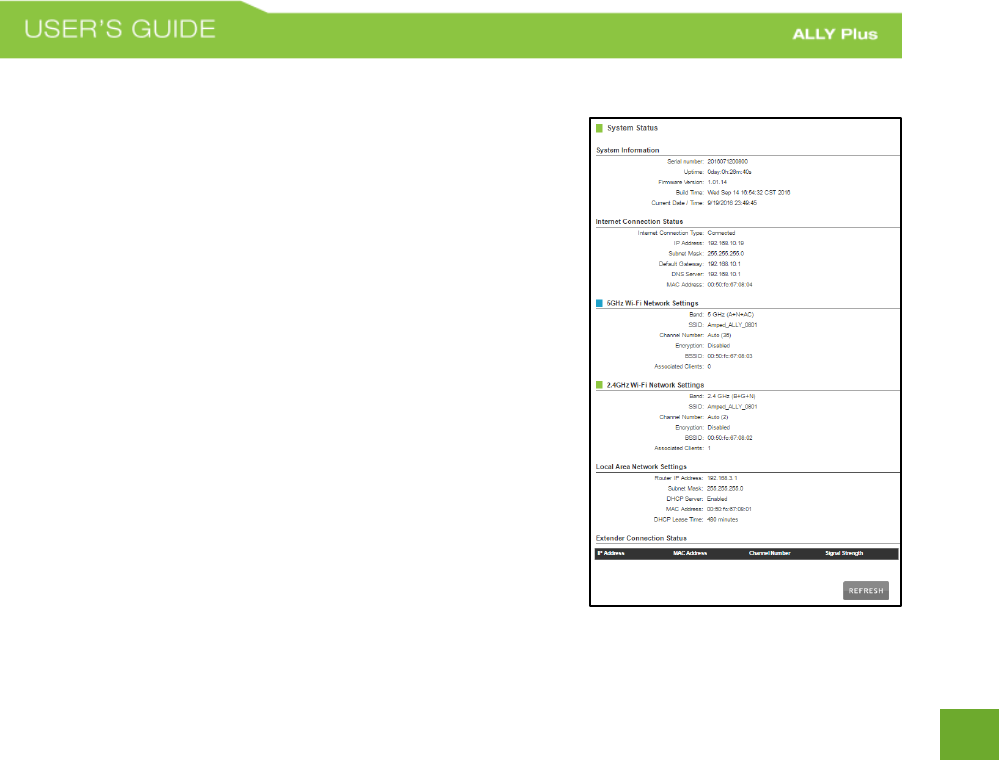
76
Management: System Status
The System Status provides you with a snapshot of your Router’s
current connections and settings.
The System Information section provides you with the router’s
firmware version and build. This is used to help our support
department determine what firmware version your device is running.
The Current Date / Time is the setting for the system clock. If this
time is off, go to the System Clock section and configure your system
time.
The Internet Connection Status displays the information from your
Internet Provider. If for some reason your Internet connection stops
working, you may try running through the Basic Setup Wizard again or
contact our support department at 888-573-8820.
The Wireless Settings shows the details of the 2.4GHz and 5.0GHz
wireless networks.
The Local Area Network settings displays the current configurations
for local network IP address and DHCP server settings.
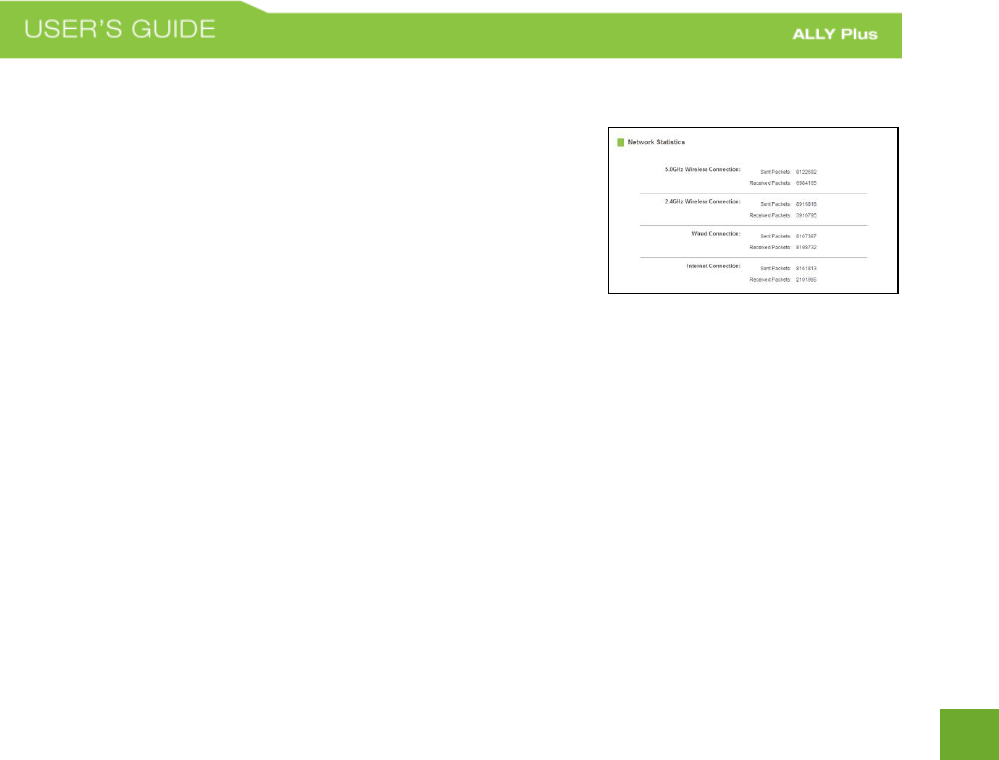
77
Management: Network Statistics
Network statistics shows the data activity for each connection type on
the Router (Internet, Wireless and Wired).
The Wireless Connection statistics shows all data activity for both the
2.4GHz and 5.0GHz wireless networks separately.
The Wired Connection statistics shows all data activity for all users
physically connected to the wired ports on the Router.
The Internet Connection statistics shows the data activity for all upload and download data over your Internet
connection.

78
Management: Dynamic DNS Settings
The Dynamic Domain Name System (DDNS) is a method to keep a web domain name, or web address, linked
to a changing IP address as most Internet Providers do not provide static IP addresses.
To use DDNS, you must first set up an account with a DDNS provider. The Router supports two of these
providers (TZO and DynDNS). Once the DDNS service has been set up and configured correctly on the Router,
the DDNS service will constantly track the IP address of your Internet connection. Each time your Internet
Provider changes your IP address, the Router will inform the DDNS service and the DDNS service will update
your new IP address. The DDNS web domain that you have chosen to use will then be updated to redirect to
your new Internet IP address.
The DDNS service makes it so you never have to
check or remember your Internet IP address. This
feature is typically used for users running servers,
network cameras and other devices that require
remote access.

79
Management: System Clock
Maintain the internal clock for the Router by syncing with your computer’s time or over the Internet. Your
system clock settings need to be accurate in order for logs and wireless access schedules to work correctly.

80
Management: System Logs
The System Log is useful for viewing the activity and history of your Router. The System Log is also used by
Amped Wireless technicians to help troubleshoot your router when needed. It is recommended that you
enable all logs in the event that troubleshooting is required.
All log entries will be deleted each time the Router reboots or is powered off.

81
Management: Upgrade Firmware
Amped Wireless continuously updates the firmware for all
products in an effort to constantly improve our products and
their user experiences. When connected to an active
connection with Internet access, the Range Extender can
automatically check for new firmware updates that are
available by pressing Check Now. Follow the prompts to
complete the upgrade process.
Before upgrading the firmware, remember to always save
your current settings first by going to the Save/Reload
Settings page. The firmware upgrade process will reset the
settings of the Range Extender to default settings.
Manual Firmware Upgrade: In the case that the Range Extender does not have access to the Internet, you can
manually upgrade the firmware by downloading the firmware file from the Amped Wireless Elite Support
website. The firmware update is downloaded as a zip file and you will need to have an unzipping program to

82
open the file. Inside the file will be a text document with details on the current firmware release and
instructions on how to upgrade the firmware.
To manually upgrade your firmware:
a) Download the file from www.ampedwireless.com/support and remember the location where you
saved it. Firmware files may also be provided by Amped Wireless Elite Support Concierges.
b) Click Choose File and locate the file.
c) Click Upload to begin upgrading.
Note: Firmware files normally have a .bin file extension.
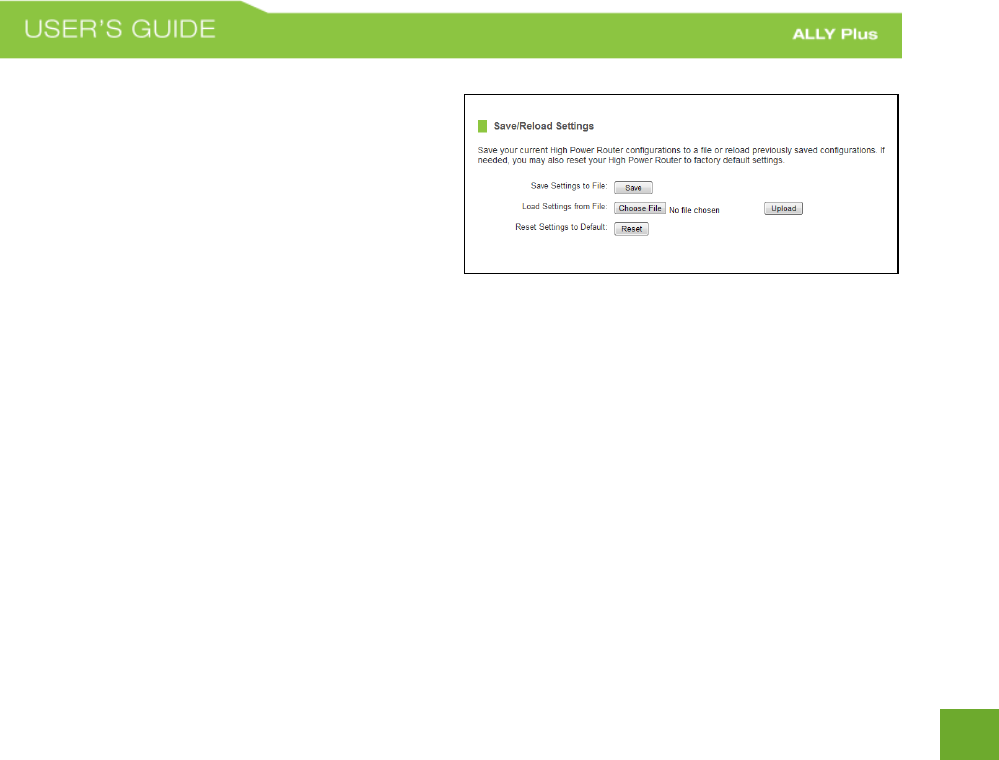
83
Management: Save and Reload Settings
Saving your current settings allows you to back-up
your current settings which may be reloaded at a later
time. This feature may be useful for testing new
features and settings without having to worry about
returning to a stable platform.
To save current settings:
a) Click Save.
b) Select a file name and location.
To load previously saved settings:
a) Click Browse.
b) Locate the previously saved settings file.
c) Click Upload to restore the settings to the
saved file.
You may also reset the Router’s settings to factory settings by pressing Reset. By resetting the Router, you will
lose all previous configurations and will need to run the Basic Setup Wizard again to configure the Router’s
Settings.
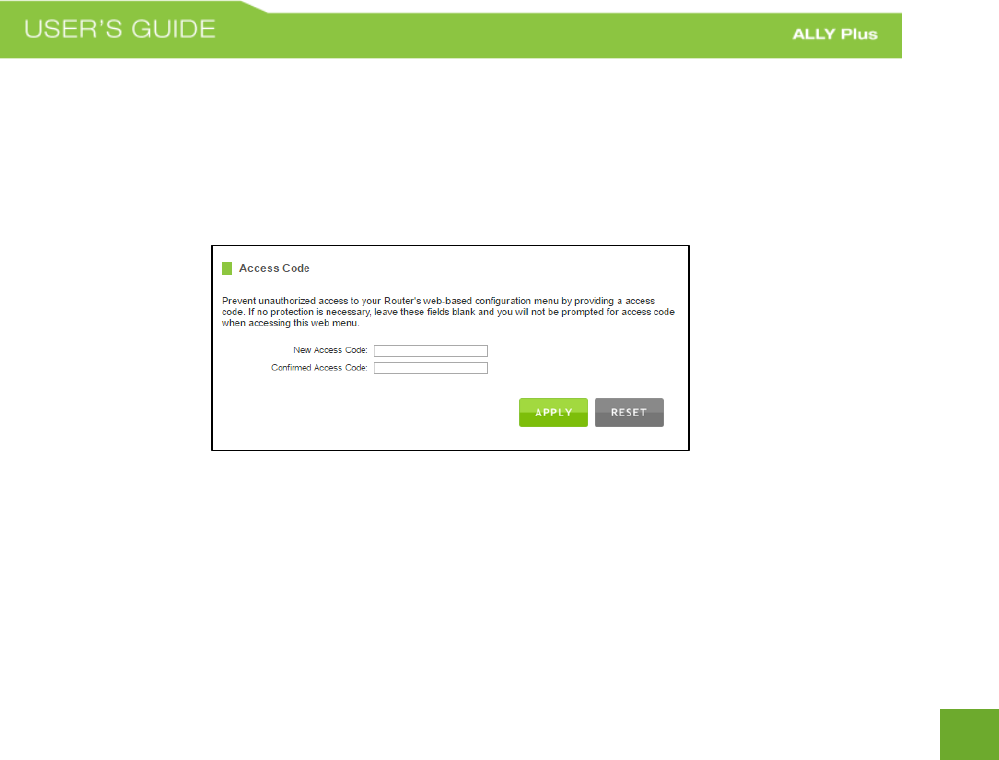
84
Management: Access Code
If you wish to enable an access code to protect unauthorized access to the web menu and Setup Wizard, you
may enter one here.

85
TECHNICAL SPECIFICATION
ALLY Router
Wireless Standard: 802.11a/b/g/n/ac
Frequency Band: 2.4/5GHz
Wireless Speed: 2.4GHz: 600Mbps (Tx/Rx)
5.0GHz: 1300Mbps (Tx/Rx)
Amplifier: 4 x 2.4GHz Internal Amplifiers
3 x 5.0GHz External Amplifiers
7 x Low Noise Amplifiers
Memory: 128MB DDR3
Processor: Dual Core Processor
Antennas: 4 x Internal High Gain Antennas
Ports: 3 x RJ-45 10/100/1000 LAN ports
1 x RJ-45 10/100 /1000 WAN ports
1 x USB 3.0 Port for Storage Devices
Warranty: 1 Year
ALLY Extender
Wireless Standard: 802.11a/b/g/n/ac
Frequency Band: 2.4/5GHz
Wireless Speed: 2.4GHz: 600Mbps (Tx/Rx)
5.0GHz: 1300Mbps (Tx/Rx)
Amplifier: 4 x 2.4GHz Internal Amplifiers
3 x 5.0GHz External Amplifiers
7 x Low Noise Amplifiers
Memory: 128MB DDR3
Processor: Dual Core Processor
Antennas: 4 x Internal High Gain Antennas
Ports: 1 x RJ-45 10/100/1000 LAN ports
Warranty: 1 Year

86
DEFAULT SETTINGS
The default settings for your Router are listed here. If for some reason you need to return your Router back to
default settings, hold down the Reset button on the back panel for 10 seconds. The Router will reset back to
factory settings as listed below:
IP Address: 192.168.3.1
Web Menu Access: http://setup.ampedwireless.com
2.4GHz and 5GHz Wireless SSID: Amped_ALLY_XXXX
Wireless Security Key (WPA/WPA2 Mixed Mode): None

88
Troubleshooting
The tips in this guide are listed in order of relevance. Try solution (a) before trying solution (b), etc.
Troubleshooting: ALLY Setup Issues (Using the app)
During Setup on the ALLY app I get an error message that says: “No Internet detected” and I cannot finish the
setup.
a) Reset your modem by holding down the reset button located on the back of the modem for
approximately five seconds. Try the automatic configuration again.
b) Static IP: Your Internet connection may require a static IP setting. Check with your ISP to obtain the IP
settings. You can set Static IP using the ALLY app by running through the setup process and tapping
“Manually configure your ALLY” when the Connection Error page appears.
c) DSL Connections: Your Internet connection may require login information. If you are using PPPoE mode,
you will need to manually configure your Internet connection settings and obtain your username and
password. You can set a PPPoE connection using the ALLY app by running through the setup process
and tapping “Manually configure your ALLY” when the Connection Error page appears.

89
During the setup process, my new Wi-Fi settings are not successfully applied.
a) During the setup process your mobile device will disconnect from the ALLY Wi-Fi network as it applies
the new Wi-Fi settings to the ALLY Router. At this time, your mobile device may have joined another
Wi-Fi network that does not have Internet access. Please check that your mobile device is connected
to a Wi-Fi network with an active Internet connection and go back to the ALLY app.
I see an error “No Connection to ALLY” when using the ALLY app.
a) The ALLY Router and the ALLY app can no longer communicate. Check that the ALLY Router is
connected to the modem correct. Reboot your modem or the ALLY Router if necessary.
b) If you are using an Android mobile device, please check that your “Smart Network Switch” is toggled
off.
How can I remove my ALLY Router from my ALLY app account?
a) Go to the ALLY app and tap on the settings icon on the top right corner of the home screen. From the
settings screen tap “Erase all data & disconnect ALLY”. This will remove your ALLY Router and allow
you to set the ALLY Router to a new account or an existing account.

90
Which mobile devices can I use to set up and manage my ALLY?
a) To set up your ALLY with the ALLY app, you need and Android or iOS device with an Internet
connection. Currently we support Android 4.4 and up and iOS 9 and up.
How do I set up my ALLY if I don’t have cell data service?
a) If you cannot download the app, please access the web setup by connecting your mobile device to the
ALLY’s Wi-Fi network. Open a web browser and go to http://setup.ampedwireless.com Follow the
instructions on the screen to complete setup.
Troubleshooting: Using the ALLY App
My Network
How can I tell if my network is up and running?
a) If your network is up and running, the header of the Home screen of the ALLY app is green, and you’ll
see a message that says “ALLY is online”. If your network is offline, the header is red, and it will say
“ALLY is offline”.

91
How do I find my Wi-Fi network password?
a) Open the ALLY app.
b) On the Home screen, tap the Devices button to open the Connected Devices list.
c) Tap the + sign in the top-right corner. Here you can see the network names and passwords for all your
Wi-Fi networks.
NOTE: You should be careful about who you give your passwords to.
How do I change my Wi-Fi network name and password?
a) Open the ALLY app.
b) On the Home screen, tap the gear icon in the upper-right corner to open the Settings menu.
c) Under the Network section, tap Edit Wi-Fi Networks.
d) To edit, tap the network name or the network password. Enter a new network name and/or network
password.
NOTE: Passwords must be 8 to max 15 characters long.
TIP: Tap the magic wand to create a strong password automatically.
e) When done, tap Save.

92
How do I share my Wi-Fi network with guests?
a) ALLY allows you to create a Guest Wi-Fi for sharing your Wi-Fi without giving access to your main
network where all your personal devices are communicating. To create a the Guest Wi-Fi follow the
steps below.
b) Open the ALLY app.
c) On the Home screen, tap the gear icon in the upper-right corner to open the Settings menu.
d) Under the Guest Network section, toggle the Guest Wi-Fi switch to turn on.
You can disable the Guest Wi-Fi at any time by following the same steps.
How do I identify the devices on my network?
a) Devices that show up in your devices list may look unfamiliar because their names are confusing or
unclear. If you come across a device that you don’t recognize, look for the manufacturer’s name on
the Devices screen and see if you recognize it. If that doesn’t work, you may also look up your device’s
MAC address and compare it to the MAC address that is shown on the Device Settings screen. The
MAC address of a device can usually be found in the About Device section in your device’s Settings.

93
How do I see how many devices are on my network?
a) You can see a list of all registered devices and whether they are online or offline on the Devices
screen.
I see an error “No Connection to ALLY” when using the ALLY app.
a) The ALLY Router and the ALLY app can no longer communicate. Check that the ALLY Router is
connected to the modem correct. Reboot your modem or the ALLY Router if necessary.
Cyber Security
How does AVG protection work?
a) When enabled AVG protection scans the Internet traffic on your network and automatically blocks
known malicious links or websites right on the router, before they reach your connected devices.

94
Do I need an Antivirus if I have AVG protection enabled?
a) AVG protection provides an additional layer of security for your connected devices. It does not
replace an antivirus product. We recommend that you install and use an up-to-date antivirus product.
Parental Controls
Filtered website is still showing.
a) Website Filtering may take some minutes to come into effect across your devices. If you keep having
trouble with Website Filtering, please feel free to give us a call.
I can still launch apps that I blocked.
a) App Blocking allows you to manage Internet access for individual apps and services. Apps that do not
require an Internet connection, like games, may still work.

95
Curfew does not turn off devices.
a) Curfew lets you set times for when you want your family members to be offline and not access the
Internet. Curfew does not lock devices. Apps and services that can be launched and used without an
Internet connection may still work.
Manage ALLY
Can my ALLY network have more than one administrator?
a) Currently, ALLY only allows one administrator per network.
I forgot my password.
a) Try to login to the ALLY app and tap on Forgot Password. Enter your email address and follow the
instructions on the screen.

96
How do I change my ALLY app password?
a) Go to the AVG My Account website: https://myaccount.avg.com Log in using your ALLY app details.
Then select My Profile in the menu bar. Here you can change your ALLY account password.
How can I remove my ALLY Router from my ALLY app account?
a) Go to the ALLY app and tap on the settings icon on the top right corner of the home screen. From the
settings screen tap “Erase all data & disconnect ALLY”. This will remove your ALLY Router and allow
you to set the ALLY Router to a new account or an existing account.
How do I check if there is a firmware update available?
a) ALLY app will automatically alert you if a firmware update is available when you use the app. If you
want to check for updates, go to Settings and tap Firmware Update.

97
What type of data does ALLY collect and why?
a) We care about your privacy and want you to have more control over how we collect and use your
data. Please read our privacy policy to understand what data we collect, why we collect it, and how
we use it. To read the ALLY App Privacy and Cookie Policy, visit:
http://www.chimewifi.com/privacypolicy/
Troubleshooting: Web Menu Issues
I wish to configure advanced settings on the Router such as changing Wi-Fi channels, configuring port
forwarding, Quality of Service settings, etc.
a) To access the advanced settings menu, connect to the ALLY’s Wi-Fi network. Open a web browser
and go to: http://setup.ampedwireless.com You will be prompted for a password which can be found
on the ALLY app by going to Settings (icon on the top right corner of the status page) and then going
to Advanced settings. Some features on the Web Menu will be disabled when the Router is in use
with the ALLY app.

98
I wish to use the ALLY Router and Extender without the ALLY app. How do I do this?
a) If you have never set the ALLY Router up using the ALLY app follow these steps: Power on the ALLY
Router and connect to the ALLY’s Wi-Fi network. Open a web browser and go to:
http://setup.ampedwireless.com to access the web menu and web based setup wizard. Follow the
steps to configure your ALLY Router
b) If you have previously configured the ALLY Router using the ALLY app and you wish to no longer use
the ALLY app with the Router follow these steps. While the ALLY Router is powered on, reset the ALLY
Router by pressing the Reset button on the bottom of the Router for 10 seconds. The status light
should blink rapidly when the Router has been reset. Once this is done, follow the steps in “a” to
configure the Router using the web menu.
I entered setup.ampedwireless.com and it failed to open the Setup Wizard.
a) Make sure your computer is connected to the Router using the included Ethernet cable. Do not try to
connect with a wireless connection. Ensure that the power on the Router is on.
b) Check that your computer IS NOT connected to any wireless networks. If it is, disable your Wi-Fi
connection and disconnect from all wireless networks. Reboot the router and try again.
c) Close your current web browser and reopen it. Use Google Chrome or Internet Explorer (v8.0 and up).
d) Open your web browser and enter 192.168.3.1 into the web address bar.

99
e) If you can access the web menu, but not the Setup Wizard, the Router may have previously been
configured. There is a link to re-access the Setup Wizard from the Dashboard. Scroll to the bottom of
the Dashboard page to find the Setup Wizard link.
f) Another way to access the Setup Wizard is to reset the Router to default settings by holding the Reset
Button (located on the back panel) for ten (10) seconds and try again. The Setup Wizard will always
appear if the Router has not yet been configured. After it has been configured the Dashboard will
appear instead.
I entered setup.ampedwireless.com and it failed to open the Web Menu Dashboard.
a) Make sure your computer is connected to the Router using the included Ethernet cable. Do not try to
connect with a wireless connection. Ensure that the power on the Router is on.
b) Check that your computer IS NOT connected to any wireless networks. If it is, disable your Wi-Fi
connection and disconnect from all wireless networks. Reboot the router and try again.
c) Close your current web browser and reopen it. Use Google Chrome or Internet Explorer (v8.0 and up).
d) Open your web browser and enter 192.168.3.1 into the web address bar.
e) If the Setup Wizard appears instead of the Dashboard, the Router has not yet been configured.
Complete the Setup Wizard or skip the Setup Wizard to access the Dashboard.
f) Reset the Router to default settings by holding the Reset Button (located on the back panel) for ten (10)
seconds and try again. Complete the Setup Wizard or skip the Setup Wizard to access the Dashboard.

100
I have entered setup.ampedwiress.com, but I cannot enter the Web Menu. I am prompted for a access code
but it does not let me continue.
a) Check that you are using the right access code.
b) If you forgot your login and password for the Web Menu, reset the Router to default settings and try
again. To reset the Router to default:
- On the back panel of the router find the Reset button.
- Use a pen tip to hold down the reset button for 5 to 10 seconds.
- The router will reinitialize and restore its default settings.
I am having problems with features on the Web Menu. When clicking buttons, it does not register my action.
a) Check that you are using a supported web browser: Google Chrome, Internet Explorer (8.0 and up) and
Safari. If you are using an unsupported web browser, such as Firefox, please change to one of the
supported web browsers and try again.

101
Troubleshooting: Internet Connection Issues
The ALLY Setup could not automatically configure my Internet connection.
a) Reset your modem by holding down the reset button located on the back of the modem for
approximately five seconds. Try the automatic configuration again.
b) Static IP: Your Internet connection may require a static IP setting. Check with your ISP to obtain the IP
settings.
c) DSL Connections: Your Internet connection may require login information. If you are using PPPoE
mode, you will need to manually configure your Internet connection settings and obtain your
username and password.
d) Cable Modem: Your Internet connection may require you to clone your MAC address. Go to More
Settings > IP Settings > Internet Network (WAN) and select Automatic/Dynamic (DHCP) from the drop
down menu. Clone your PC’s MAC address under the DNS settings.
I have gone through the Setup Wizard and I do not have Internet.
a) Detach the power adapter and disconnect all computers from the ALLY Router.
Turn off the power to your modem and remove the backup battery (if available).
Wait 2 minutes and power the modem back on. Wait 2 minutes for the modem to initialize.

102
Power on the Router and connect your computer to the router.
Open your web browser and try to access the Internet.
b) Check that your Internet connection through the modem is working. Power off the ALLY Router and
disconnect your computer from the router.
Turn off the power to your modem and remove the backup battery (if available).
Wait 2 minutes and power the modem back on. Wait 2 minutes for the modem to initialize.
Attach your computer directly to the modem and power on your computer.
Open your web browser and check to see if you can go online. If you cannot go online, there may be a
problem with your Internet provider. Please contact your Internet provider to troubleshoot your
connection issues.
My Internet connection is unstable and drops intermittently.
a) Power off your computer, the ALLY Router and your modem.
Power on your modem and wait 2 minutes.
Power on the Router and wait 1 minute for the router to initialize.
Power on your computer and try again.
b) Check to see if other computers are also having this problem. If they are not, check to see if your anti-
virus software or firewall software is conflicting with your Internet connection. You may also try
temporarily disabling all firewalls or anti-virus software to see if that is what is causing the problem.

103
c) If you have a PPPoE or another Internet connection requiring login credentials, you may need to adjust
the reconnection or time out settings. If you are using the Web Menu for setup: Go to the IP Settings >
Internet Connection (WAN) page and configure your Internet connection to automatically reconnect.
For ALLY App based setups select manual setup once the Internet connection detection error page
appears.
d) If you are using Windows XP, check that your computer is using Service Pack 2 or greater. Windows XP
users with Service Pack 1 may experience intermittent wireless connections.
My Internet connection is abnormally slow.
a) Check with your Internet provider to ensure that they are not experiencing system wide issues.
b) Check with speedtest.net to see the speed of your Internet provider. Connect directly to your modem
with your computer and check speedtest.net again. If the speed results are the same, the issue is with
your Internet provider. Please contact your provider to troubleshoot the issue.
c) Check the Internet connection speed on another computer that is connected to the Router. If the other
computer does not have Internet speed problems, the networking equipment or operating system on
your original computer may be outdated or may be experiencing problems. Viruses and other software
may slow down a computer’s overall speed significantly.
d) If you are using a wireless connection to the Router, check that your wireless signal strength is above 3
bars. If not, you may need to move closer to the Router.

104
Troubleshooting: Local Network Issues
My computer is getting an IP address of 169.254.x.x and Windows says “Limited or no Connectivity”.
a) Make sure the Router is powered on.
b) Check that your computer’s network adapter is enabled and is set to “Obtain IP Address
Automatically”.
c) Release and Renew your IP Address on your computer. To do this on a Windows computer:
- Click Start > Run and type CMD.
- When the command prompt appears, type ipconfig/release and press enter.
- Type ipconfig/renew and press enter.
-Check that your computer’s network adapter has an IP address of 192.168.3.x
d) Restart your computer and check again.
e) Restart the Router and check again.
f) Make sure DHCP is enabled in the Router’s Web Menu (Go to More Settings > IP Settings > Local Area
Network (LAN) > DHCP Settings.
g) Check that your Firewall or Anti-Virus software is not preventing you from accessing shared devices on
you network.

105
Troubleshooting: Wireless Issues
My Wi-Fi coverage is poor or my Wi-Fi speeds seem slow. It doesn’t seem like my ALLY Extender is working.
a) Power on the ALLY Extender and check that the status LED is either green or orange. If the color is
red this means the ALLY Extender is too far from the ALLY Router. Power off the ALLY Extender and
move it to a location closer to the ALLY Router and power it on again. Check that the ALLY Extender
LED is green or orange. If it is still red repeat the above steps.
b) If the ALLY Extender LED is flashing red, this means it does not have a connection to the ALLY
Router. Check that the ALLY Router is powered on. If it is, reboot the ALLY Extender by powering it
off and back on. If the LED remains flashing red, move the ALLY Extender closer to the ALLY Router
and check again until the LED turns green or orange.
c) If your LED remains flashing red after trying (a) and (b), please contact Elite Support.
I currently have multiple Wi-Fi network names appearing when I scan for Wi-Fi networks. (There should be
no more than one 2.4GHz network and one 5GHz network).
a) Reboot the ALLY Router first by powering it off and back on, then reboot the ALLY Extender.
Wait three minutes and then check the Wi-Fi network names are correct.
b) If option “a” does not work, move your ALLY Extender closer to the ALLY Router and try again.

106
I am only getting 3 or 4 wireless signal bars on my wireless computer and I am within 10 feet of the wireless
router.
a) Step back at least 10 feet from the ALLY Router and check your signal again. The ALLY Router emits
high power, long range Wi-Fi signals that may confuse your wireless adapter signal reading at close
range. The speed and signal are at 100%, however your readout may not be displaying the data
correctly.
b) Change the wireless channel on your ALLY Router to find a channel with less interference. Do this for
both 2.4GHz and 5.0GHz wireless networks. To assist in finding the right channel, download the Amped
Wireless Wi-Fi Analytics Tool for your Android or PC. Changing the Wi-Fi channels can be done via the
Web Menu and not the ALLY app.
I am not getting a strong wireless connection from all distances from the ALLY router.
a) Check if other computers are experiencing the same issue. If not, the wireless adapter in your computer
may be experiencing problems or maybe older and have poor wireless performance.
b) Avoid placing the ALLY Router near or around Microwaves and 2.4GHz wireless phones.
c) Avoid using wireless channels that are crowded. Change the wireless channel on the ALLY Router.
d) Place the ALLY Router in a higher location near the center of your desired coverage location.

107
My wireless adapter does not connect at the maximum wireless speed.
a) Your wireless network adapter may be outdated and have older wireless technology not capable of
achieving the wireless network speeds of the Router. To achieve maximum wireless speeds, it is
required that you have an 802.11n (2.4GHz) or 802.11ac (5.0GHz) adapter. To obtain a data rate of
1733Mbps on the 5GHz band or 800Mbps on the 2.4GHz band the network adapter used to connect to
the Router must support the same data rates.
b) Wireless speeds degrade as you get further away from the wireless router.
c) Check that the wireless channel set on the Router is not crowded. Try changing the wireless channel
to another channel and test the speed again.
d) Do not use Internet websites (i.e. speedtest.net or other websites) to test your wireless speeds. Speed
test websites measure your Internet connection speed, which is controlled by your Internet provider.
Wireless speeds are for your local network and not your Internet connection. To test wireless speeds,
a local test or file transfer will be required to test the true wireless speed.
I cannot tell if MU-MIMO simultaneous data transfers are enabled and functioning.

108
a) Check that the connected devices support MU-MIMO technology. All connected devices must also
support MU-MIMO to enable the MU-MIMO function. If the connected device does not support MU-
MIMO it will function as a SU-MIMO (single-user MIMO) device.
I cannot connect my Windows Vista computer to the wireless network. I enter my wireless password and I
see an error.
a) Manually add a wireless network to your Vista computer:
- Click Start, and then click Network.
- Select Network and Sharing Center.
- Click Manage Wireless Networks.
- Click Add and select Manually create a network profile.
- Type in the SSID, and select the type of security and enter your security key.
-Select “Start this connection Automatically” and click Next.
- Go to Network and Sharing Center and select Manage Network Connections.
- Right click Wireless Network Connection and then select Status.
- Click details and check to see that your IPv4 IP address is correct (192.168.3.x).
b) Disable IEEE 802.1x authentication on your computer.

109
I cannot connect my Windows XP computer to the wireless network. I enter my wireless password and I see
an error.
a) Make sure your computer has the latest Windows Service Pack. Windows Service Pack 1 does not
support WPA security. Upgrade to the latest Service Pack to support the latest wireless encryption.
b) Manually add a wireless network to your XP computer.
c) Disable IEEE 802.1x authentication.
Troubleshooting: USB Storage Issues
I cannot access my USB storage device after I plug it into the ALLY router.
Follow the instructions below for your operating system. The USB Storage function is configured via the Web
Menu and not the ALLY App.
Windows 7 and Vista
To access the drive from your Windows desktop:

110
Note: If the USB drive does not appear automatically under your Networked devices (Windows 7, Vista or Mac OS X), you will need to Map
the Network Drive.
a) Click the Start button.
b) Click Computer.
c) On the Computer page, the drive should appear on the left hand column under Network as
Amped_USB.
To Map the Network Drive:
a) Click the Start button.
b) Click Computer.
c) Click Map Network Drive from the top bar.
d) Select a drive letter (any), then enter in the folder field either of the following depending on which
USB port is being used:
\\AMPED_USB\usb3\ or \\router’s LAN IP address\usb3\
e) If the drive fails to open, click browse and locate Amped_USB under Network.
Windows XP
To access the drive from your Windows desktop:
Note: If the USB drive does not appear automatically under your Networked devices (Windows 7, Vista or Mac OS X), you will need to Map
the Network Drive.
a) Click the Start button.

111
b) Click My Computer.
c) Click on My Network Places and locate the drive named Amped_USB.
To Map the network drive:
a) Click the Start button.
b) Right Click My Computer and select Map Network Drive.
c) Select a drive letter (any), then enter in the folder field either of the following depending on which
USB port is being used:
\\AMPED_USB\usb3\ or \\router’s LAN IP address\usb3\
d) If the drive fails to open, click browse and locate Amped_USB under Network.
Mac OS X
To access the drive from your Mac desktop:
Note: If the USB drive does not appear automatically under your Networked devices (Windows 7, Vista or Mac OS X), you will need to Map
the Network Drive.
a) Open Finder.
b) On the left hand menu, under Shared, click Amped USB.
To Map the network drive:
a) Open Finder.
b) From the menu on the top of the desktop, select Go.

112
c) Select Connect To Server from the drop down menu.
f) Enter the address of the network drive: Amped_USB or shared disk IP address, then click Connect
I cannot access my USB storage device remotely.
a) Insert a USB storage device, such as a flash drive or external hard drive, to the USB port on the back or
side of the Router.
b) From the USB Storage/FTP Server page of the web menu, enter a FTP server name.
c) Select whether you wish to have an open or secured access to your FTP server.
d) Open your FTP client software (not provided) and create a new FTP connection.
To find a FTP client software, go to downloads.com and search for FTP client software. Download a
FTP software suitable for your needs and continue with the next step.
e) Enter the Internet Address for the router as the IP address for your FTP connection. When prompted
enter your login information to access the USB Storage device remotely.

113
The Router freezes or I cannot access the web when a USB storage device is connected.
a) Remove the USB storage device from the Router and reboot it by unplugging the power adapter. Once
rebooted, try inserting the USB storage device again.
b) Make sure your UBS storage device is not corrupted and is working properly and try again.
Additional USB Storage troubleshooting tips may be available online at the Amped Wireless Elite Support Center.
Please check the Elite Support Center for the latest updates and features for USB Storage support.

114
WARRANTY AND REGULATORY INFORMATION
The Amped Wireless (A division of Newo Corporation, Inc.) Limited Warranty
Warranty Period: The Amped Wireless Limited Warranty is for one (1) year from the date of purchase for new
products. Refurbished products carry the Limited Warranty for thirty (30) days after the date of purchase.
Guarantee: Amped Wireless warrants to the original purchaser that the hardware of this Amped Wireless
product shall be free of defects in design, assembly, material, or workmanship.
Conditions: The Amped Wireless Limited Warranty is for repair or replacement only at the sole discretion of
Amped Wireless. Amped Wireless does not issue any refunds for purchased product. In the event that Amped
Wireless is unable to repair or replace a product (i.e. discontinued product), Amped Wireless will offer a credit
toward the purchase of a similar product of equal or lesser value direct from Amped Wireless. Any repaired or
replacement products will be warranted for the remainder of the original Warranty Period or thirty (30) days,
whichever is longer. Amped Wireless reserves the right to discontinue any of its products without notice, and
disclaims any limited warranty to repair or replace any such discontinued product. Amped Wireless reserves
the right to revise or make changes to this product, its documentation, packaging, specifications, hardware,
and software without notice. If any portion of the Amped Wireless Limited Warranty is found to be
unenforceable, its remaining provisions shall remain in effect. All costs of shipping the product to Amped
Wireless shall be borne solely by the purchaser.

115
Limitations: IN NO EVENT SHALL AMPED WIRELESS’ (NEWO CORPORATION’S) LIABILITY EXCEED THE AMOUNT
PAID BY YOU FOR THE PRODUCT FROM DIRECT, INDIRECT, SPECIAL, INCIDENTAL OR CONSEQUENTIAL
DAMAGES RESULTING FROM THE USE OF THE PRODUCT, ITS ACCOMPANYING SOFTWARE, ACCESSORIES OR
ITS DOCUMENTATION. The Amped Wireless Limited Warranty does not apply if: (a) the product assembly has
been opened or damaged, (b) the product or its software or firmware has been altered or modified, (c) the
product has not been used and installed in accordance to Amped Wireless’ instructions, (d) the product has
been subjected to misuse, or negligence. Amped Wireless does not guarantee the continued availability of a
third party’s service for which this product’s use or operation may require. The Amped Wireless Limited
Warranty does not protect against acts of God, vandalism, theft, normal wear and tear, obsolescence and
environmental damages such as, but not limited to, weather and electrical disturbances. The Amped Wireless
Limited Warranty is the sole warranty for this product. There are no other warranties, expressed or, except
required by law, implied, including the implied warranty or condition of quality, performance merchantability,
or fitness for any particular purpose.
How to Claim Warranty: In the event that you have a problem with this product, please go to
www.ampedwireless.com/support to find help on solving your problem. In the event that you cannot and
need to file a warranty claim, please call Amped Wireless’ Elite Support or visit
http://www.ampedwireless.com/support/center.html#rma to obtain a Support Ticket Number (obtained from
Technical Support Reps), fill out a Return Authorization (RMA) form and obtain a Return Authorization (RMA)
number. A dated proof of original purchase and the RMA number is required to process warranty claims. You
are responsible for properly packaging and shipping the product at your cost and risk to Amped Wireless. The

116
bearer of cost related to shipping repaired or replaced product back to the purchaser will be at the sole
discretion of Amped Wireless and determined based on the details of each RMA case. Customers outside of
the United States of America are responsible for all shipping and handling costs including custom duties, taxes
and all other related charges.
Technical Support: The Amped Wireless Limited Warranty is not related to the terms, conditions and policies
of Amped Wireless Elite Support offerings. For questions regarding support, please contact
techsupport@ampedwireless.com

117
Regulatory Information
FCC Statement and Declaration: Amped Wireless declares that this device complies with Part 15 of the FCC
Rules and Regulations. Operation of this device is subject to the following two (2) conditions:
(1) This device may not cause harmful interference.
(2) This device must accept any interference received, including interference that may cause undesired
operation.
FCC Notice: This equipment has been tested and found to comply with the limits for a Class B digital device,
pursuant to Part 15 of the FCC Rules. These limits are designed to provide reasonable protection against
harmful interference in a residential installation. This equipment generates, uses and can radiate radio
frequency energy and, if not installed and used in accordance with the instructions, may cause harmful
interference to radio communications. However, there is no guarantee that interference will not occur in a
particular installation. If this equipment does cause harmful interference to radio or television reception,
which can be determined by turning the equipment off and on, the user is encouraged to try and correct the
interference by one or more of the following measures:
- Reorient or relocate the receiving antenna.
- Increase the distance between the equipment and the receiver.

118
- Connect the equipment to an outlet on a circuit different from that to which the receiver is
connected.
- Consult the dealer or an experienced radio/TV technician for help.
FCC Caution and Safety Notices: Any changes or modifications (including the antennas) made to this device
that are not expressly approved by the manufacturer may void the user’s authority to operate the equipment.
This device and its antenna(s) must not be co-located or operating in conjunction with any other antenna or
transmitter. Avoid use of this product near water or during an electrical storm as there may be a remote risk
of electrical shock from lighting. This product may contain lead, known to the State of California to cause
cancer, and birth defects or other reproductive harm. Wash hands after handling. This device must always be
used with a Listed Computer or device.
For product available in the USA/Canada market, only channel 1~11 can be operated. Selection of other
channels is not possible. This device is restricted to indoor use when operated in the 5.15 to 5.25 GHz
frequency range.
FCC requires this product to be used indoors for the frequency range 5.15 to 5.25 GHz to reduce the potential
for harmful interference to co-channel Mobile Satellite systems.

119
FCC Radiation Exposure Statement: This equipment complies with FCC radiation exposure limits set forth for
an uncontrolled environment. This equipment should be installed and operated with minimum distance 23 cm
between the radiator & your body.
The antennas used for this transmitter must be installed to provide a separation distance of at least 23 cm
from all persons and must not be co-located or operating in conjunction with any other antenna or
transmitter.

120
Industry Canada Statement: This device complies with Industry Canada license-exempt RSS standard(s).
Operation is subject to the following two conditions:
(1) this device may not cause interference, and
(2) this device must accept any interference, including interference that may cause undesired operation
of the device.
Radiation Exposure Statement: This equipment complies with IC radiation exposure limits set forth for an
uncontrolled environment. This equipment should be installed and operated with minimum distance 23 cm
between the radiator and your body.
The transmitter must not be co-located or operating in conjunction with any other antenna or transmitter.
For product available in the USA/Canada market, only channel 1~11 can be operated. Selection of other
channels is not possible.
The device for operation in the band 5150–5250 MHz is only for indoor use to reduce the potential for harmful
interference to co-channel mobile satellite systems.

121
Déclaration d’Industrie Canada : Le présent appareil est conforme aux CNR d'Industrie Canada applicables aux
appareils radio exempts de licence. L'exploitation est autorisée aux deux conditions suivantes :
(1) l'appareil ne doit pas produire de brouillage, et
(2) l'utilisateur de l'appareil doit accepter tout brouillage radioélectrique subi, même si le brouillage est
susceptible d'en compromettre le fonctionnement.
Déclaration d’exposition à la radiation : Cet équipement respecte les limites d’exposition aux rayonnements
IC définies pour un environnement non contrôlé. Cet équipement doit être installé et mis en marche à une
distance minimale de 23 cm qui sépare l’élément rayonnant de votre corps.
L’émetteur ne doit ni être utilisé avec une autre antenne ou un autre émetteur ni se trouver à leur proximité.
Pour les produits disponibles aux Etats-Unis / Canada du marche, seul le canal 1 a 11 peuvent etre exploites.
Selection d'autres canaux n'est pas possible.
Les dispositifs fonctionnant dans la bande 5150-5250 MHz sont reserves uniquement pour une utilisation a
l’interieur afin de reduire les risques de brouillage prejudiciable aux systemes de satellites mobiles utilisant les
memes canaux.

122
LEGAL NOTICES & DISCLAIMERS
Copyright Information and Trademark Usage Guidelines
© 2016 Amped Wireless / Newo Corporation. All rights reserved. Amped Wireless, Newo Corporation, and the
Amped Wireless logo are registered trademarks or trademarks of Newo Corporation. All non-Amped Wireless
trademarks, logos, brands and products are trademarks or registered trademarks of their respective owners.
Amped Wireless does not claim any relation. Mention of non-Amped Wireless products and brands are for
information purposes only and does not constitute an endorsement or affiliation.
Amped Wireless authorizes you to copy materials published by Amped Wireless solely for non-commercial use
within your organization in support of Amped Wireless products. No other use of this information is
authorized. Any copy of these materials which you make shall retain all copyright and other proprietary notices
in the same form and manner as on the original. Except as specified above, nothing contained herein shall be
construed as conferring by implication, estoppel or otherwise any license or right under any patent, trademark
or copyright of Amped Wireless or any third party.
All contents of this product, including Software, are protected by copyright, except as permitted herein. No
portion of the information may be reproduced without prior written permission from Amped Wireless. The

123
distribution, modification, publication and transmission of any content of this product for public or commercial
purposes is strictly prohibited.
The Amped Wireless logo requires permission for use. For use of the Amped Wireless logo, please email
legal@ampedwireless.com. Use of Amped Wireless' trademarks require the use of the proper trademark
symbol in all usage cases.
The guidelines for trademark usage apply to all Amped Wireless customers, employees, vendors, consultants,
licensees and any other third party.
Operating Temperature Information
This product is designed to operate in an environment with ambient temperatures ranging from 32° to 104°F.
The device should be placed on a cool, flat surface and not on carpet or any other surface that may increase
the operating temperature of the device. Do not block the vents on the device in anyway.
Disclaimers
Amped Wireless makes all attempts in providing accurate information on all media. However, Amped Wireless
makes no warranty as to the accuracy of the information, including representations and warranties about the

124
accuracy of product specifications, marketing material, product availability, new product launch dates and all
other content herein. Amped Wireless reserves the right to update and change information without prior
notice. All information provided is provided "AS IS" with all faults without warranty of any kind. Either
expressed or implied. Amped Wireless and its suppliers disclaim all warranties, expressed or implied including,
without limitation. Amped Wireless and its suppliers shall not be liable for any indirect, special, consequential,
or incidental damages including, without limitation, lost profits or revenues, cost of replacement goods, loss or
damage to data arising out of the use or inability to use any Amped Wireless product, damages resulting from
use of or reliance on information present, even with prior notice to Amped Wireless.
All non-Amped Wireless trademarks, logos, brands and products are trademarks or registered trademarks of
their respective owners. Amped Wireless does not claim any relation. Mention of non-Amped Wireless
products and brands are for information purposes only and does not constitute an endorsement or affiliation.
Product wireless range specifications are based on performance test results. Actual performance may vary due
to differences in operating environments, building materials and wireless obstructions. Performance may
increase or decrease over the stated specification. Wireless coverage claims are used only as a reference and
are not guaranteed as each wireless network is uniquely different.
Maximum wireless signal rates are derived from IEEE 802.11 standard specifications. Actual data throughput
may vary as a result of network conditions and environmental factors.

125
Wi-Fi Range Extenders may not work with non-standard Wi-Fi routers or routers with altered firmware or
proprietary firmware, such as those from third party sources or some Internet service providers. May not work
with routers that do not comply with IEEE or Wi-Fi standards.
You agree and acknowledge that Amped Wireless is not responsible and will not be liable for any claims arising
from (1) your downloading or use of any third party application that is used together with the Amped Wireless
products, including the ALLY mobile application (“ALLY App”) developed and supplied by AVG Netherlands B.V.
(“AVG”) (collectively “Third Party Applications”) and (2) any privacy policy, end user agreements or terms of
services entered or acknowledged by you in connection with using or downloading such Third Party
Application. Amped Wireless did not develop such Third Party Applications and disclaims any representation or
warranty, including any implied warranty, that such Third Party Applications will operate with the Amped
Wireless product or that such Third Party Applications will operate in accordance with such specifications,
representations or warranties provided with or applicable to such Third Party Applications.
You further agree and acknowledge that any personal information collected by Amped Wireless in connection
with your use of Amped Wireless products, including such information submitted by you as part of or relating
to (i) product registration or set up (including on or through Amped Wireless’ website) or (ii) technical or
customer service or support inquires, will be subject to the terms and conditions set forth in Amped Wireless’
privacy policy set forth on this link http://www.ampedwireless.com/legal.html#privacy

126
You agree and acknowledge that your use of the ALLY App developed and supplied by AVG is conditioned up
agreement to and subject to the terms of service located at www.chimewifi.com/tos (“AVG TOS”) and the
privacy policy located at www.chimewifi.com/privacypolicy (“AVG Privacy Policy”). YOU ACKNOWLEDGE AND
AGREE THAT AVG HAS NO LIABILITY FOR ANY AMPED WIRELESS HARDWARE, SOFTWARE OR FIRMARE AND
THE AVG TOS LIMITS AVG’S LIABILITY TO YOU AND REQUIRES THAT YOU SUBMIT TO ARBITRATION FOR THE
RESOLUTION OF ANY CLAIM YOU MIGHT HAVE AGAINST AVG. You further agree that AVG may change the
ALLY App or cease offering the ALLY App at any point without notice, and without liability to you.
End User License Agreement
This product contains embedded software (namely, firmware), licensed to you, the purchaser, by Amped
Wireless (the “Software”). This license agreement (the “License Agreement”) and the terms and conditions
herein apply to your use of such Software with the Product. Please be aware that this License Agreement does
not cover software or mobile applications downloaded from an authorized website, such as
www.ampedwireless.com or from an authorized application market such as Google Play or Apple’s App Store,
including but not limited to Third Party Applications.
This License Agreement allows you to operate the Software in the manner described in the user’s manual for
the purchased product. You can make as many copies of the Software as needed for your personal use.
Modifying of or tampering of the Software, including but not limited to any Open Source Software, is solely at

127
your own risk. Amped Wireless is not responsible for any such modification or tampering. Amped Wireless
will not support or warrant any product in which you have or have attempted to modify the Software provided
by Amped Wireless. You may not lease, sublicense, resell, redistribute or otherwise transfer the Software
without written consent from Amped Wireless.
Amped Wireless may from time to time develop patches, bug fixes, updates, upgrades and other modifications
to improve the performance of the Software and related services (“Updates”). These may be automatically
installed without providing any additional notice or receiving any additional consent. You consent to this
automatic update. If you do not want such Updates, your remedy is to stop using the Product. If you do not
cease using the Product, you will receive Updates automatically. You acknowledge that you may be required to
install Updates to use the Product and the Software and you agree to promptly install any Updates Amped
Wireless provides. Your continued use of the Product is your agreement to these terms.
THE SOFTWARE IS PROVIDED TO YOU “AS IS” WITH ALL FAULTS AND WITHOUT WARRANTIES OF ANY KIND. In
particular, Amped Wireless does not guarantee that the Software will be error-free or that the Software will be
free from system threats or attacks from viruses. Amped Wireless does not warrant that the Software will
meet your expectations or that the software will be suitable for your particular situation. Amped Wireless
warrants that any media (such as an included CD) on which the Software is provided to be free from defects. If
you have an eligible warranty claim for defective media, Amped Wireless will replace the Software media.

128
Certain items of software included with the Software are subject to “open source” or “free software” licenses
(“Open Source Software”). Some of the Open Source Software is owned by third parties. The Open Source
Software is not subject to the terms and conditions of this License Agreement. Instead, each item of Open
Source Software is licensed under the terms of the end user license that accompanies such Open Source
Software. Nothing in this License Agreement limits your rights under, or grants you rights that supersede, the
terms and conditions of any applicable end user license for the Open Source Software. If required by any
license for particular Open Source Software, Amped Wireless makes such Open Source Software, and Amped
Wireless modifications to that Open Source Software, available by written request to Amped Wireless at the
email or mailing address listed below.
IT IS YOUR RESPONSIBILITY TO BACK UP YOUR SYSTEM INCLUDING, WITHOUT LIMITATION, ANY DATA THAT
YOU MAY USE OR POSSESS IN CONNECTION WITH THE PRODUCT. ANY MATERIAL, INFORMATION OR DATA
DOWNLOADED OR OTHERWISE OBTAINED IS ACCESSED AT YOUR OWN DISCRETION AND RISK, AND YOU WILL
BE RESPONSIBLE FOR ANY DAMAGE TO YOUR COMPUTER SYSTEM OR PRODUCT, OR LOSS OF DATA THAT
RESULTS FROM THE DOWNLOAD OF SUCH MATERIAL, INFORMATION OR DATA.
YOU ARE USING THE SOFTWARE AND THE PRODUCT AT YOUR OWN DISCRETION AND RISK. YOU WILL BE
SOLELY RESPONSIBLE FOR (AND AMPED WIRELESS DISCLAIMS) ANY AND ALL LOSS, LIABILITY, OR DAMAGES,
INCLUDING TO YOUR HOME, PRODUCT, OTHER PERIPHERALS CONNECTED TO THE PRODUCT, COMPUTER,
MOBILE DEVICE, AND ALL OTHER ITEMS AND PETS IN YOUR HOME, RESULTING FROM YOUR USE OF THE
PRODUCT OR SOFTWARE.

129
All title and copyrights in and to the Software and any copies thereof are owned by Amped Wireless or its
partners/suppliers. All title and intellectual property rights in and to the content which may be accessed
through use of the Software is the property of the respective content owner and may be protected by
applicable copyright or other intellectual property laws and treaties. This License Agreement grants you no
rights to use such content. You may not delete any copyright, trademark or other proprietary notices from the
Software or documentation.
Nothing in this License Agreement, including the following limitation of liability provision, shall attempt to
exclude liability that cannot be excluded under applicable law.
TO THE MAXIMUM EXTENT PERMITTED BY APPLICABLE LAW, IN ADDITION TO THE ABOVE WARRANTY
DISCLAIMERS, IN NO EVENT WILL (A) AMPED WIRELESS BE LIABLE FOR ANY CONSEQUENTIAL, EXEMPLARY,
SPECIAL, OR INCIDENTAL DAMAGES, INCLUDING ANY DAMAGES FOR LOST DATA OR LOST PROFITS, ARISING
FROM OR RELATING TO THIS LICENSE AGREEMENT AND THE PRODUCTS AND SOFTWARE, EVEN IF AMPED
WIRELESS KNEW OR SHOULD HAVE KNOWN OF THE POSSIBILITY OF SUCH DAMAGES, AND (B) AMPED
WIRELESS’ TOTAL CUMULATIVE LIABILITY ARISING FROM OR RELATED TO THIS LICENSE AGREEMENT AND THE
PRODUCTS AND SOFTWARE, WHETHER IN CONTRACT OR TORT OR OTHERWISE, EXCEED THE FEES ACTUALLY
PAID BY YOU TO AMPED WIRELESS OR ITS AUTHORIZED RESELLER FOR THE PRODUCT AT ISSUE IN THE PRIOR
12 MONTHS (IF ANY). THIS LIMITATION IS CUMULATIVE AND WILL NOT BE INCREASED BY THE EXISTENCE OF
MORE THAN ONE INCIDENT OR CLAIM. AMPED WIRELESS DISCLAIMS ALL LIABILITY OF ANY KIND OF AMPED
WIRELESS’ LICENSORS AND SUPPLIERS.

130
Binding Arbitration and Class Action Waiver Provision
Application. This Binding Arbitration and Class Action Waiver Provision applies to any Dispute arising from or
related to this “LIMITED WARRANTY, TERMS & CONDITIONS, LICENSES, DISCLAIMERS, COPYRIGHT &
REGULATORY INFORMATION,” including the License Agreement (collectively, the “Warranty and Agreement”)
or your use of our Products, Software or services and involving you and Amped Wireless. “Dispute,” for purposes
of this provision, means any dispute, action, or other controversy regardless of the particular cause of action(s)
asserted (i.e., it encompasses, among any other potential cause of action or legal basis, claims for breach of
contract, fraud, and violation of statute or regulation).
Notice. In the event of a Dispute, you must provide Amped Wireless with a notice of Dispute, which is a written
statement of the name, address and contact information of the party giving it, the facts giving rise to the Dispute,
and the relief requested. You must send any Notice of Dispute by email to Amped Wireless at
legal@ampedwireless.com (stating Subject: Notice of Dispute Under Warranty and Agreement).
CLASS ACTION WAIVER. ANY PROCEEDINGS TO RESOLVE OR LITIGATE ANY DISPUTE IN ANY FORUM WILL BE
CONDUCTED SOLELY ON AN INDIVIDUAL BASIS. YOU WILL NOT SEEK TO HAVE ANY DISPUTE HEARD AS A CLASS
ACTION, PRIVATE ATTORNEY GENERAL ACTION, OR IN ANY OTHER PROCEEDING IN WHICH EITHER PARTY ACTS
OR PROPOSES TO ACT IN A REPRESENTATIVE CAPACITY. NO ARBITRATION OR PROCEEDING WILL BE COMBINED

131
WITH ANOTHER WITHOUT THE PRIOR WRITTEN CONSENT OF ALL PARTIES TO ALL AFFECTED ARBITRATIONS OR
PROCEEDINGS.
Agreement to Arbitrate. If you and Amped Wireless do not resolve any Dispute by informal negotiation, any
other effort to resolve the Dispute will be conducted exclusively by binding arbitration governed by the United
States Federal Arbitration Act (“FAA”), 9 U.S.C. § 1 et seq, except as specified in the “Exceptions to Agreement
to Arbitrate” paragraph immediately below. Except as provided in the “Exceptions to Agreement to Arbitrate”
paragraph immediately below, you are giving up the right to litigate (or participate in litigation as a party or class
member) all Disputes in court before a judge or jury. Instead, all Disputes will be resolved before a neutral
arbitrator, whose decision will be final except for a limited right to judicial review under the FAA. Any court with
jurisdiction over the parties may enforce the arbitrator’s award.
Exceptions to Agreement to Arbitrate. (1) Small Claims Court. You may litigate any Dispute in small claims court,
in the county or other similar political subdivision in which you reside, if the Dispute meets all requirements to
be heard in the small claims court. If you initiate a claim in small claims court, you are responsible for all court
costs and fees. (2) Intellectual Property. All Disputes concerning any alleged misappropriation of your or Amped
Wireless’ intellectual property, will be resolved in court.
Arbitration Procedures. Any arbitration will be administered by the American Arbitration Association (the “AAA”)
in accordance with the AAA’s “Consumer Arbitration Rules” effective September 1, 2014, including the “Costs of

132
Arbitration (Including AAA Administrative Fees)” effective September 1, 2014 (collectively, the “Consumer
Procedures”).
Arbitration Costs. The Consumer Procedures provide for certain fees, specifically allocating some to the
consumer (you) and others to the business (Amped Wireless). If your claim is US$75,000 or less, Amped Wireless
will pay all of those specified fees and costs, including those allocated to the consumer. Amped Wireless does
not agree to bear any other costs. If your claim is more than US$75,000, the Consumer Procedures will govern
payment.
Laws And Rules Governing Arbitration. Except as provided in the Business Customer Disputes paragraph below,
the AAA's Consumer Procedures shall be applied to any Dispute between the parties. However, pursuant to
Consumer Arbitration Rule R-1(e), a party may raise the proper application of the Consumer Arbitration Rules
to an arbitrator for a final decision. This Warranty and Agreement, including the Binding Arbitration and Class
Action Waiver Provision, governs to the extent it conflicts with the Consumer Procedures. In ruling on a Dispute,
the neutral arbitrator will apply the terms of this Agreement and the laws of the State of California. You will
commence arbitration only in the county or other similar political subdivision in which you reside. The
arbitration proceedings will be conducted by conference call. However, if the proceedings are conducted
pursuant to the AAA Consumer Procedures, the arbitrator(s) shall have the discretionary authority to require a
face-to-face hearing upon the request of a party.

133
AAA Not Integral To Agreement To Arbitrate. You and Amped Wireless agree that the use of the AAA to
administer arbitration is not integral to the parties' agreement to arbitrate Disputes. If the AAA will not or cannot
conduct an arbitration, you and Amped Wireless shall negotiate in good faith to agree on a sole arbitrator who
shall resolve the Dispute as provided in the Consumer Procedures. If the parties cannot agree on an arbitrator,
a court of competent jurisdiction may appoint an arbitrator, who shall follow the AAA's Consumer Procedures.
Severability. If one or more parts of this Binding Arbitration and Class Action Waiver Provision are found to be
illegal, invalid or unenforceable as to all or some parts of a Dispute, then, and only in that circumstance, those
parts will be severed and the Dispute will be resolved subject to all remaining parts of this Binding Arbitration
and Class Action Waiver Provision and all other provisions of this Warranty and Agreement. If such severance
results in all or some parts of a Dispute proceeding in a court of law, exclusive jurisdiction for any such court
proceeding shall be the state or federal courts sitting in the State of California. For purposes of any such court
proceeding, you consent to, and will not challenge, the California courts’ personal jurisdiction over you, and you
further waive objection based upon improper venue or forum non conveniens and will not seek transfer to
another district or jurisdiction. Any conflict between the Warranty and Agreement and the specific terms of the
Binding Arbitration and Class Action Waiver Provision shall be governed by the Binding Arbitration and Class
Action Waiver Provision.
Business Customers Disputes. If you purchased a Product, Software or service for other than personal or
household use, all Disputes will be subject to this Binding Arbitration and Class Action Waiver Provision, with the

134
following exceptions: The arbitration proceedings, including the payment of costs, will be administered in
accordance with the AAA's Commercial Arbitration Rules (the "Commercial Procedures"). The Commercial
Procedures are appropriately applied to any Dispute between the parties, and you will not advocate otherwise
in any proceeding. However, this Warranty and Agreement, including the Binding Arbitration and Class Action
Waiver Provision, governs to the extent it conflicts with the Commercial Procedures.
Contact Us
Email Contact
Amped Wireless
Email: legal@ampedwireless.com
Web: www.ampedwireless.com
Elite Support
USA Toll Free: 888-573-8820
International: +1-909-217-3168
Email: techsupport@ampedwireless.com
Web: www.ampedwireless.com/support

Amped Wireless
A Division of Newo Corporation
Copyright © 2016 Amped Wireless / Newo Corporation. All rights reserved.
Amped Wireless, Newo Corporation, and the Amped Wireless Logo are registered trademarks or trademarks of Newo Corporation.
888-573-8820
techsupport@ampedwireless.com
www.ampedwireless.com
tech support
e-mail
web
